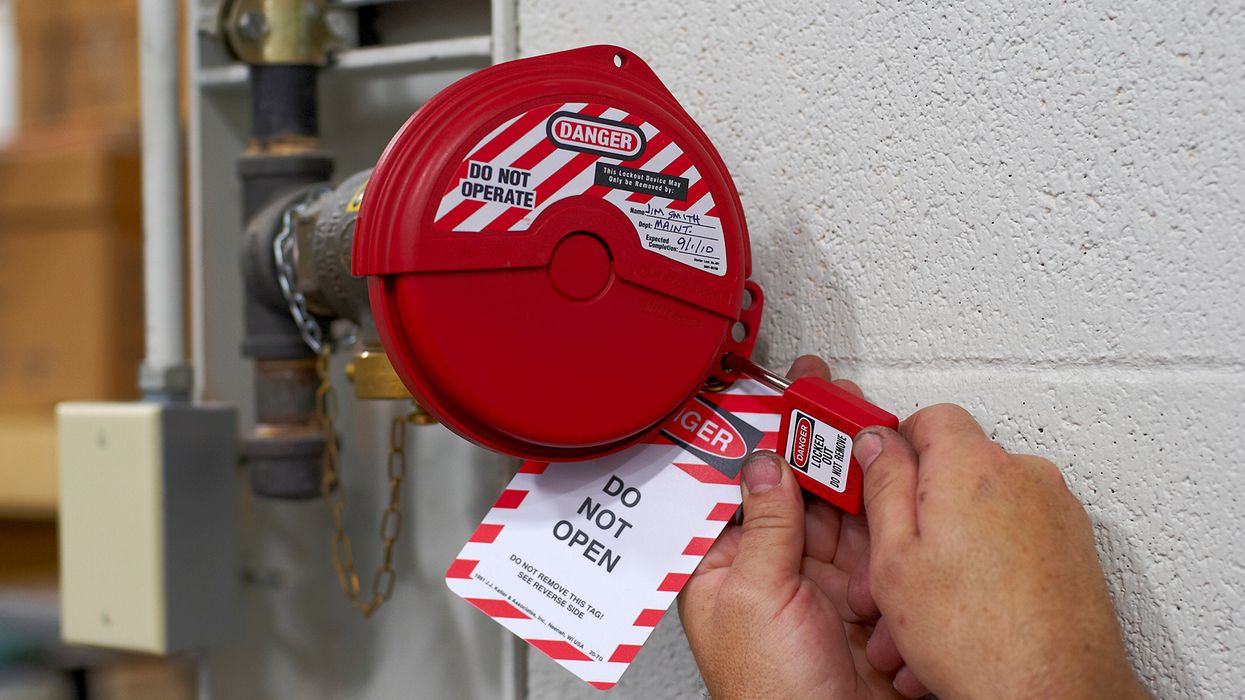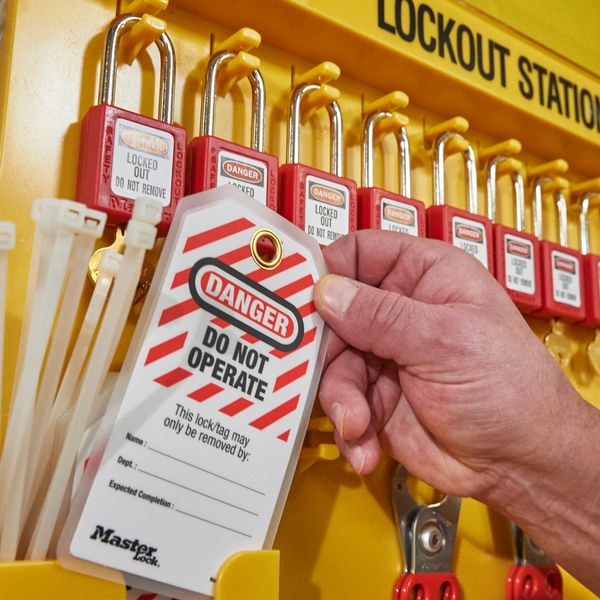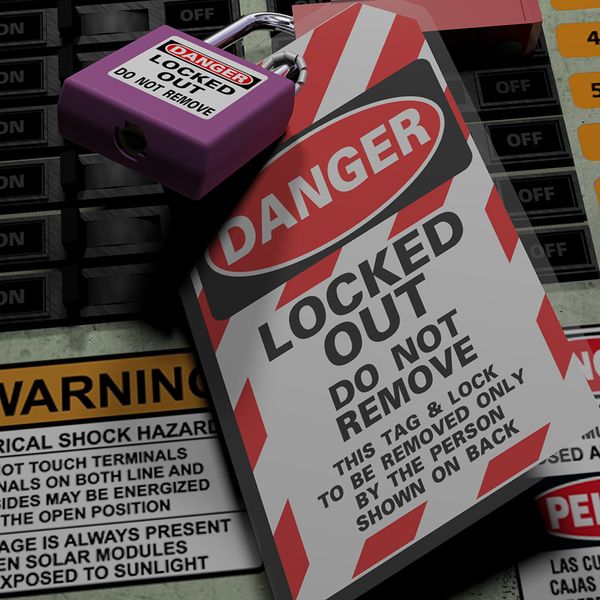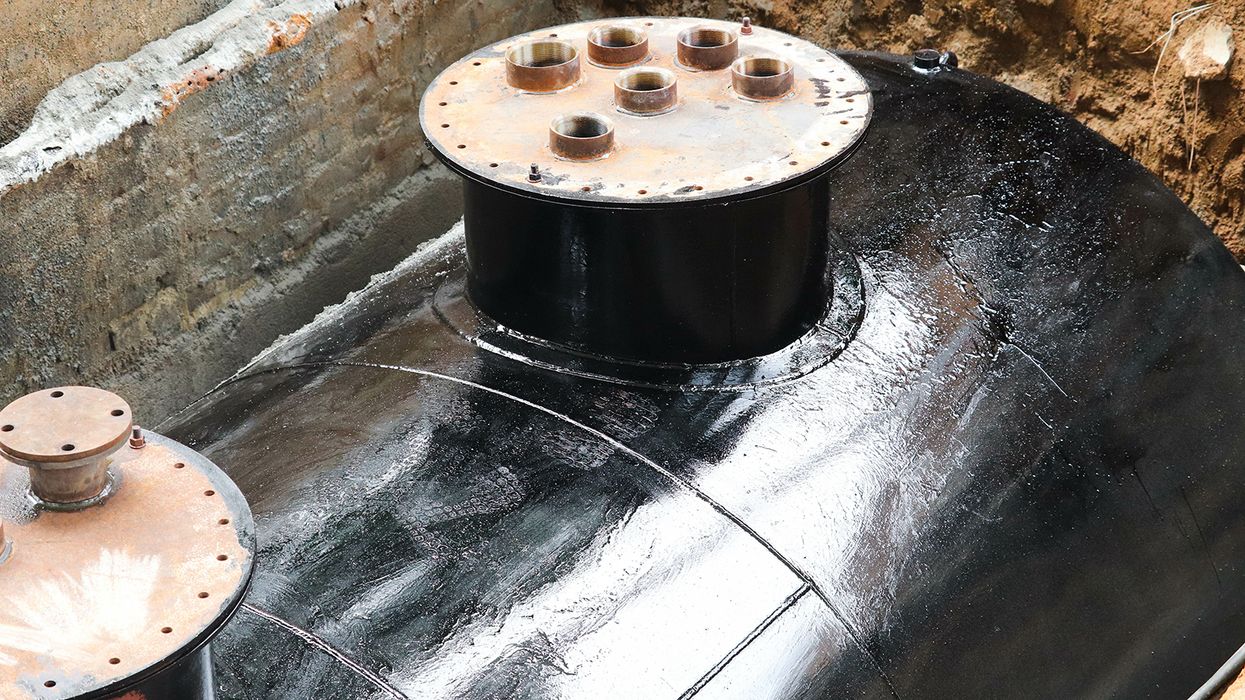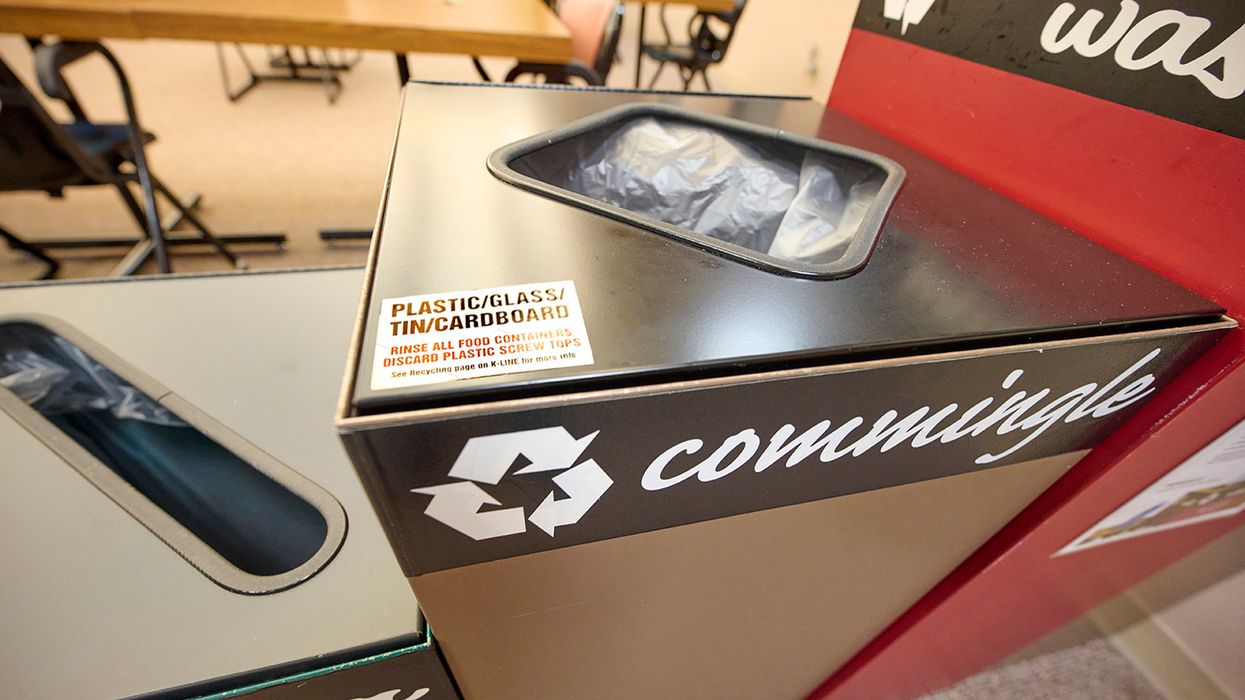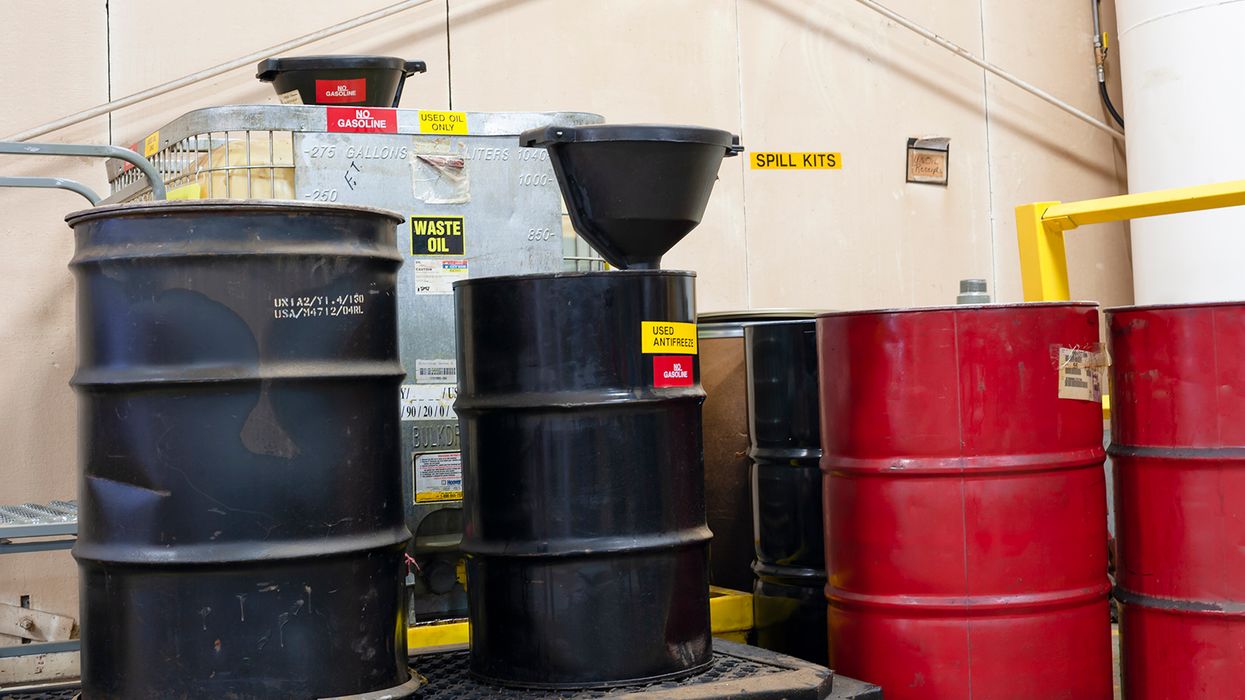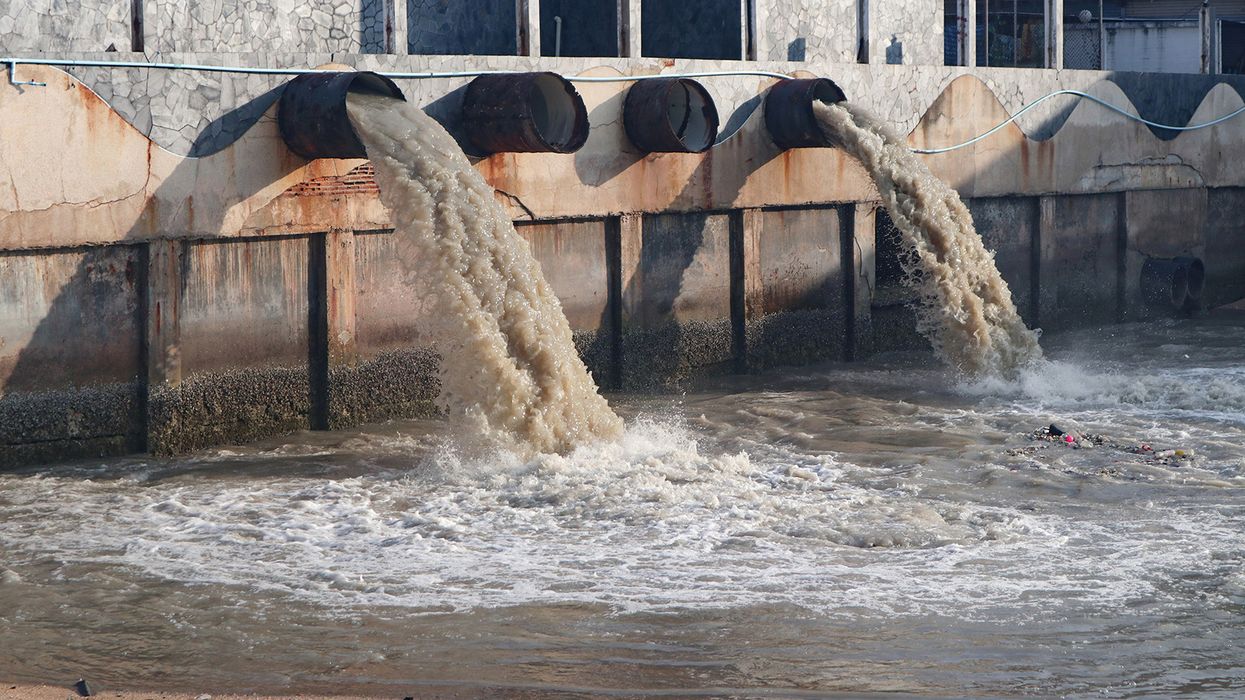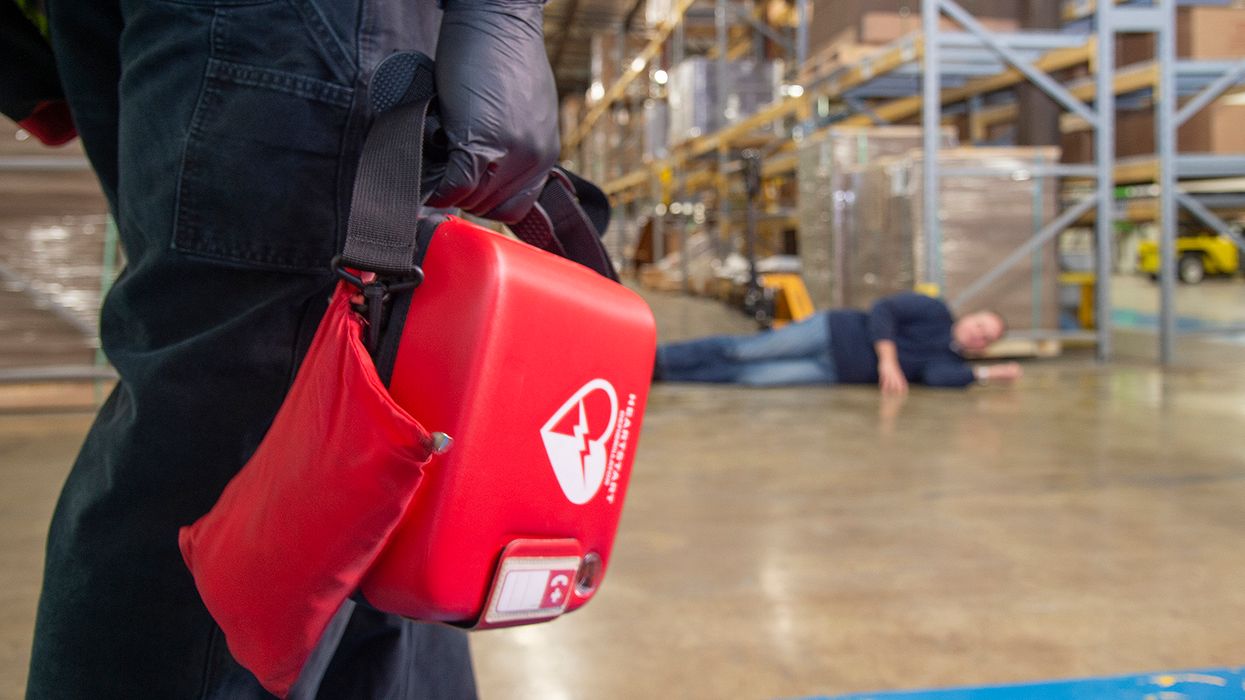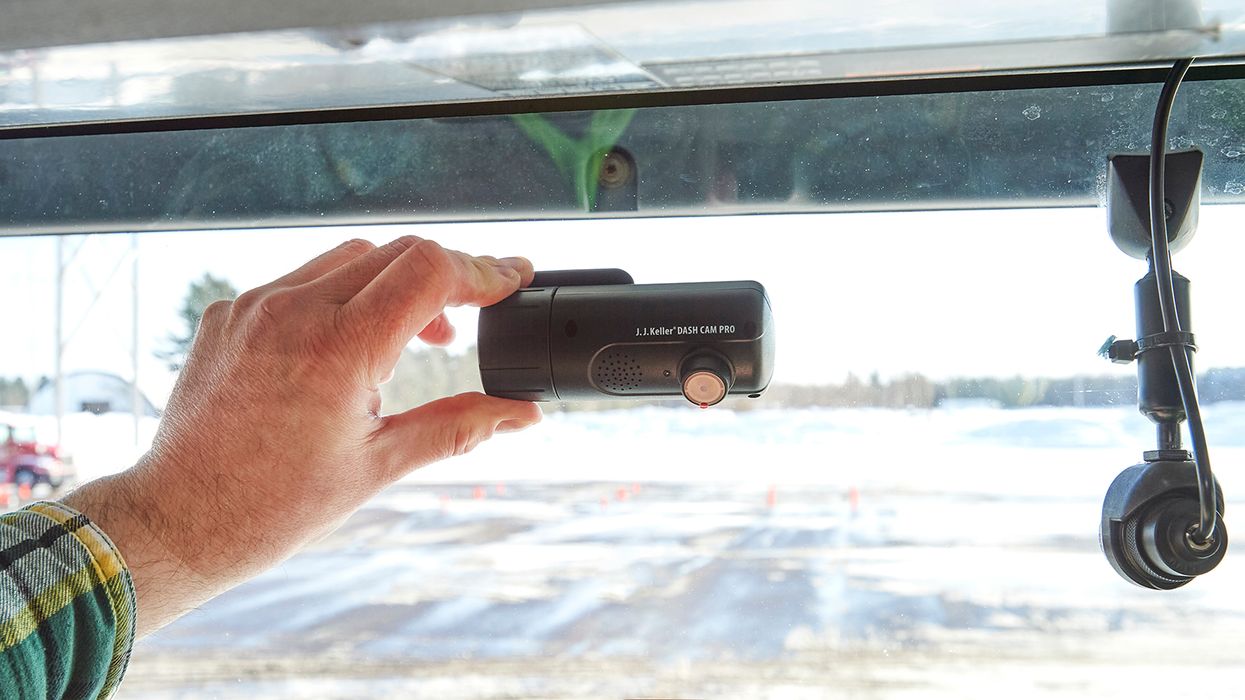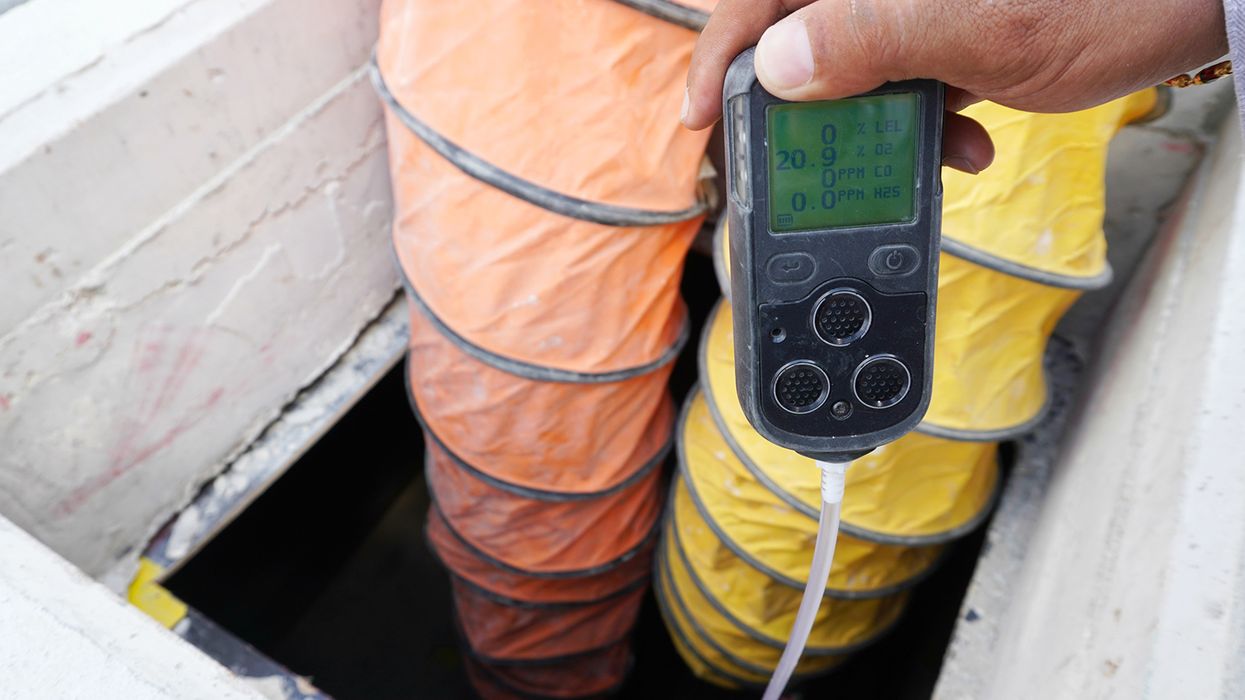RELATED NEWS

Specialized Industries
Go beyond the regulations! Visit the Institute for in-depth guidance on a wide range of compliance subjects in safety and health, transportation, environment, and human resources.
J. J. Keller® COMPLIANCE NETWORK is a premier online safety and compliance community, offering members exclusive access to timely regulatory content in workplace safety (OSHA), transportation (DOT), environment (EPA), and human resources (DOL).

Interact With Our Compliance Experts
Puzzled by a regulatory question or issue? Let our renowned experts provide the answers and get your business on track to full compliance!

Upcoming Events
Reference the Compliance Network Safety Calendar to keep track of upcoming safety and compliance events. Browse by industry or search by keyword to see relevant dates and observances, including national safety months, compliance deadlines, and more.
SAFETY & COMPLIANCE NEWS
REGSENSE® REGULATORY REFERENCE
THE J. J. KELLER INSTITUTE
ADD HAZMAT, ENVIRONMENTAL, & HR RESOURCES
DIRECT ACCESS TO COMPLIANCE EXPERTS
EVENTS
Most Recent Highlights In Environmental
UST release detection equipment: Testing 1, 2, 3
The next time you’re at a service station, consider the fact that you’re standing above underground tanks holding the fuel that you’re pumping into your vehicle. This brings up an important question about any underground tank: Since you can’t see the tank, how do you know if it starts to leak? The answer is a release detection system.
The Environmental Protection Agency (EPA) requires that all regulated underground storage tanks (USTs) have release detection systems and that owners and operators of USTs test the equipment annually to ensure it operates correctly.
Let’s look at three aspects of release detection equipment testing: how to conduct testing, what to test for, and what to record.
1. How do I test the equipment?
UST owners and operators may conduct release detection equipment testing according to:
- The manufacturer’s instructions,
- Industry codes and standards, or
- The implementing agency’s requirements.
Manufacturer’s instructions
Each piece of release detection equipment should have an associated manual or guide for owners to reference. The manual or guide will explain how to test the equipment.
Tip: Most equipment manufacturers provide online versions of their product manuals and guides, which you can likely find on the manufacturer’s website. If you can’t find guidance, contact the manufacturer directly.
Industry codes and standards
EPA’s regulations stipulate that UST owners and operators who follow industry codes and standards must choose ones developed by a nationally recognized association (like ASTM International or the Petroleum Equipment Institute (PEI)) or an independent testing laboratory.
For instance, the agency states at 280.40(a)(3) that UST owners and operators may use PEI/RP1200, Recommended Practices for the Testing and Verification of Spill, Overfill, Leak Detection and Secondary Containment Equipment at UST Facilities, to comply.
Implementing agency requirements
EPA’s rules for testing release detection equipment serve as the minimum standards. Most state regulatory agencies implement UST programs and may impose stricter or additional requirements. Plus, local regulations may apply.
Check state and local rules to ensure your UST complies with the right requirements.
2. What do I test?
At a minimum, UST owners and operators must test the following factors that apply to their release detection systems.
- Automatic tank gauges and other controllers: Test the alarms and battery backups. Verify the system’s configuration.
- Probes and sensors: Test alarm functionality and communication with the controller. Inspect the probes and sensors for residual buildup. Ensure that the floats move freely, the cables have no kinks or breaks, and the shaft isn’t damaged.
- Automatic line leak detectors: Simulate a leak to determine whether the detector meets the operation requirements of 280.44(a).
- Vacuum pumps and pressure gauges: Confirm correct communication with the sensors and controller.
- Handheld electronic groundwater and vapor sampling equipment: Ensure the monitoring equipment operates properly.
3. What records do I have to keep?
The regulation at 280.45(b)(1) mandates that UST owners and operators keep records of the annual release detection equipment testing results for at least three years.
For each annual testing record, list:
- Each device tested,
- If the devices operated according to 280.40(a)(3) or had issues that needed attention, and
- Any corrective actions applied.
Why is release detection equipment testing so important?
Petroleum and other hazardous substances that leak from USTs can endanger human and environmental health. A leaking UST’s primary threat is groundwater contamination. Groundwater supplies drinking water for almost half of Americans.
A release detection system enables a facility to respond sooner to accidental releases and, therefore, limit potential harmful impacts — only if the equipment used for the system operates properly.
Testing your UST’s release detection equipment is vital because it allows you to identify which components function accurately and which parts have problems that need correction. A well-functioning release detection system can help your facility:
- Maintain regulatory compliance (and avoid enforcement actions like penalties for noncompliance),
- Identify opportunities to upgrade existing equipment to improve operational efficiency, and
- Protect your employees and the community in which your facility operates.
Key to remember: EPA requires facilities to test the release detection equipment used on underground storage tanks each year to make sure it operates properly.
EPA modernizes pesticide registration policy, tweaks tracking app
Pesticide registrations just became simpler, more modern, and more transparent! EPA recently updated an app and made policy changes regarding how to submit two forms. All these changes result in a streamlined pesticide registration process.
Pesticide registration tracking app
On April 18, EPA made enhancements to its MyPest app, which sources say was initially launched in mid-January. EPA is proud to say that MyPest already boasts over 1,200 registrants. The new app allows registrants of pesticide products to:
- Monitor the status of their registration submissions in real-time,
- Drill down to a detailed view of each application, and
- Communicate directly with EPA staff about registration packages in review.
Updates to MyPest include an enhanced dashboard page. The page offers information about the registrant’s cases and products. More updates are planned later this year.
Policy changes impacting two forms
On April 4, EPA announced in the Federal Register the issuance of Pesticide Registration (PR) Notice 2025-1. The notice itself is dated effective March 27, 2025. Its subject line reads, “Revised Procedures for Citing Data to Support Pesticide Registrations (EPA Forms No. 8570-34 and 8570-35).”
The latest PR notice supersedes PR Notice 98-5, dated June 12, 1998. While the revisions were proposed last June, the agency only finalized them now. According to PR Notice 2025-1:
- EPA Form 8570-34 — This is the Certification with Respect to Citation of Data. Pesticide registrants use this form to indicate how they will meet their data submission/citation obligations under the law. When a registrant refers to another company’s data, the registrant must certify that:
- It offered compensation to the original data submitter, or
- It has the original data submitter’s permission to cite the data.
- EPA Form 8570-35 — This is the Data Matrix. Pesticide registrants use this form to indicate to whom they made offers of compensation.
The two forms — EPA Forms 8570-34 and 8570-35 — have not been modified. Only policies regarding the submission of the two forms have changed. The agency:
- Eliminated the instruction to use “paper” submissions;
- Says registrants should complete and submit the two forms electronically through the Pesticide Submission Portal;
- Eliminated the instruction that registrants submit two versions of the Data Matrix, i.e., the ‘‘Internal Agency Use Copy’’ and the ‘‘Public File Copy’’; and
- Requires that registrants submit a single Data Matrix without redactions.
EPA contends that none of the information on Form 8570-35 is confidential. Put another way, none of the information on the Data Matrix is protected from public release. Therefore, the agency claims there is no reason to submit two versions of the form.
According to EPA, entities potentially affected by the policy changes include, but are not limited to:
- Crop production,
- Animal production,
- Food manufacturing, and
- Pesticide manufacturing.
Efficiencies and transparencies gained
Using electronic reporting for EPA Forms 8570-34 and 8570-35 brings efficient data transmittal, argues EPA. A bonus is that electronic reporting will also reduce errors. That’s because of automated validation tools in the portal. Submitters should experience lower costs and faster review and transmission of data, the agency adds.
In 2024, EPA received a total of 3,309 Data Matrices. Moving from two versions to just one for the Data Matrix form should save registrants and EPA time. Specifically, completing, submitting, and processing the Data Matrix should be quicker. EPA will also experience time savings when providing the public access to the information. Extra steps under the Freedom of Information Act would not be needed.
The MyPest app update is a step forward in efficiency and transparency, concludes EPA. The app enhancements are part of the agency’s overall move toward digital and streamlined processes. EPA projects that the app will improve the timeliness of pesticide registration decisions.
Key to remember
Recent actions streamline the pesticide registration process and make it more transparent. These actions relate to the MyPest app and EPA Forms 8570-34 and 8570-35.
Workplace recycling in 2025: Why it matters now more than ever
Think recycling at work is just tossing paper in a blue bin? Think again. In 2025, workplace recycling is being redefined — from a basic office task to a strategic initiative that impacts your company’s bottom line, brand reputation, and environmental footprint.
From cardboard and plastics to e-waste and food scraps, today’s leading businesses are building smarter, circular systems that turn trash into opportunity — one department at a time.
Here are five reasons why recycling matters now more than ever.
1. Environmental responsibility impacts your brand reputation
Sustainability is no longer just a corporate social responsibility (CSR) talking point. It’s a core business differentiator. As a management or EHS leader, you’re often on the frontlines of implementing the visible changes that shape public perception. Recycling programs are a low-barrier, high-impact initiative that sends a clear message to customers, investors, and employees: We walk the talk.
Failing to prioritize environmental responsibility puts your company’s reputation at risk — especially in industries with public visibility or regulatory scrutiny. Forward-thinking competitors are already using circular economy models and zero-waste initiatives to win market share.
Champion a program that reflects your company’s values and positions you as a sustainability leader in your field.
2. Compliance with local, state, and federal regulations
Recycling is no longer a “nice-to-have.” Many jurisdictions now require commercial recycling, especially for packaging waste, e-waste, and food scraps. Increasingly, regulations also demand data transparency, such as tracking waste volumes, diversion rates, and sustainability goals.
Supervisors in environmental and safety roles are responsible for ensuring compliance and minimizing risk. Violations can result in hefty fines, bad press, or loss of contracts.
Stay ahead of compliance trends and implement a recycling program that satisfies current and future requirements while keeping auditreadiness top of mind.
3. Cost savings and operational efficiency
Landfill disposal is becoming more expensive due to tipping fees and transportation costs. By diverting materials through recycling or reuse programs, companies can reduce both their environmental footprint and their operational spend.
In addition, smart material handling and waste segregation can lead to process improvements — less clutter, fewer hauling pickups, and even opportunities to monetize recyclable materials like scrap metal, cardboard, or used electronics.
Use data from your waste audits and vendor reporting to identify high-volume waste streams and optimize for both cost reduction and resource efficiency.
4. Workforce engagement, retention, and culture
Today’s workforce, particularly younger employees, is drawn to employers who align with their values. A clean, green workplace that visibly supports recycling and sustainability reinforces a positive culture, boosts morale, and improves engagement — especially when employees feel like they’re contributing to something bigger.
Recycling initiatives are also an easy win for cross-departmental engagement. Whether through green teams, signage campaigns, or employee challenges, these programs offer hands-on ways to involve everyone.
Build internal buy-in by showing how your initiatives support company values, employee wellness, and sustainability goals through shared responsibility.
5. Alignment with data-driven ESG and sustainability goals
In 2025, companies are under increasing pressure from stakeholders to report measurable progress on environmental, social, and governance (ESG) initiatives. Waste reduction, recycling rates, and landfill diversion metrics are among the top data points requested in annual sustainability reports and RFPs.
Supervisors and EHS leaders are often the owners of the data. You're tasked with tracking, verifying, and reporting on these outcomes. Without a structured recycling program in place, those metrics are impossible to capture, and your ESG report falls flat.
Establish a system for measuring, improving, and communicating progress toward zero-waste or landfill diversion targets, and support leadership in meeting ESG benchmarks.
Key to remember: Embracing workplace recycling in 2025 isn’t just good for the planet — it’s a smart move that drives innovation, saves money, and positions your company as a leader in sustainability.
EHS Monthly Round Up - March 2025
Hi everyone! Welcome to the monthly news roundup video, where we’ll review the most impactful environmental health and safety news. Let’s get started!
Ladders were the cause of over 22,000 workplace injuries and 161 deaths in 2020. Each March, the American Ladder Institute promotes ladder safety awareness with the goal of reducing ladder-related injuries and fatalities. Every Step Matters was the theme of this year’s National Ladder Safety Month.
Stand Up 4 Grain Safety Week kicked off on March 24. This annual event brings attention to preventable grain handling hazards and promotes safety in this high-hazard industry.
Federal agencies must review their regulations and report back to the White House by April 20. The priority is on “significant” rules, generally considered to be those with an annual effect on the economy of 100 million dollars or more. Once the regulations have been identified, the Office of Management and Budget and the Department of Government Efficiency will work with agency leaders to create a plan for rescinding or modifying the regulations and begin winding down their enforcement.
A highwall fatality at a surface mine prompted the Mine Safety and Health Administration to issue a safety alert. It outlines what miners should do to prevent similar incidents, including looking for hazards such as loose rocks and overhangs before beginning work.
The American Society of Safety Professionals revised its construction training standard. It outlines training requirements for new hires in construction and demolition operations, site procedures, regulatory compliance, and more.
And finally, turning to environmental news, EPA will reconsider a number of major rulemakings that may impact a variety of industries. This is in response to an executive order that federal agencies review their regulations. Among the rules under consideration include those related to clean power, oil and gas emission limits, greenhouse gas reporting, and risk management.
EPA’s Waste Emissions Charge on petroleum and natural gas facilities with high methane emissions is no longer in effect. The rule initially took effect in January and was then disapproved by Congress on March 14.
Thanks for tuning in to the monthly news roundup. We’ll see you next month!
Hazardous waste manifest errors? Follow RCRA’s correction process
Hazardous waste manifests are like travel logs. They track the entire journey of regulated hazardous waste, from the starting point (the generator’s facility) to the final destination (the off-site waste management facility). Like travel logs, a manifest is only as accurate as the information provided. Thankfully, you can correct manifest errors.
The Environmental Protection Agency (EPA) finalized the Third Rule under the Resource Conservation and Recovery Act (RCRA), which took effect in January 2025. It made noteworthy changes to the manifest corrections process. Here’s what hazardous waste generators, transporters, and treatment, storage, and disposal facilities (TSDFs) need to know.
Who’s impacted?
The Third Rule impacts entities subject to RCRA’s manifest regulations. This article focuses on the manifest correction rules that apply to these waste handlers:
- Small and large quantity generators,
- Transporters, and
- TSDFs.
Note that the final rule amends post-manifest correction regulations for other entities, such as exporters, that are beyond the scope of this article.
What are the Third Rule changes?
EPA’s final rule maintains most of the post-receipt manifest data corrections process.
What’s the same?
Specifically:
- Any waste handler named on the manifest may voluntarily submit data corrections at any time,
- Waste handlers can make an unlimited number of voluntary corrections,
- Corrections may be applied to an individual record or batch of them, and
- Submissions must include a signature that's compliant with the Cross-Media Electronic Reporting Rule (CROMERR).
What’s different?
Previously, when EPA or a state regulatory agency requested corrections to data on a manifest, waste handlers weren’t required to make them. The Third Rule now mandates that waste handlers:
- Correct errors on the manifest within 30 days of a corrections request from EPA or a state agency, and
- Make data correction submissions electronically for paper or electronic manifest records.
Post-receipt corrections are made via the Hazardous Waste Electronic Manifest System (e-Manifest) on the RCRA Information (RCRAInfo) system.
The Third Rule also clarifies that receiving facilities (TSDFs) can make corrections only after the manifest is completed (i.e., signed and submitted to the e-Manifest system).
What’s the post-receipt manifest correction process?
Waste handlers submitting voluntary or mandatory post-receipt corrections to hazardous waste manifests must follow the process established at 40 CFR 264.71(l).
Follow this general process on the e-Manifest System:
- Certify that the manifest is complete. It must have the status “Signed-Completed."
- Determine how to submit the corrected data to the e-Manifest system. You can enter the data directly into e-Manifest or upload a file with data corrections to the system.
- Include for each correction submission:
- The Manifest Tracking Number and date received by the facility associated with the data being corrected,
- The Item Number(s) of the affected data fields on the manifest form (EPA Form 8700-22), and
- The previously entered and corrected data.
- Save your corrections. The manifest’s status will change to “Under Correction."
- Re-sign the manifest to certify the corrections. The manifest’s status will change to “Corrected."
Manifest correction FAQs
Check out some top questions and answers about post-receipt manifest corrections.
What manifest information can I correct?
The type of waste handler your facility is considered determines which items on the manifest you can change for voluntary corrections or must change for mandatory corrections. Typically:
- Generators correct data in Items 1–15;
- Transporters correct data in Items 6–7, 14, and 17; and
- TSDFs correct data in Items 14 and 18–20.
What user role do I need on RCRAInfo to submit manifest corrections?
You must be registered in RCRAInfo as a user with the e-Manifest Certifier or Site Manager role for the facility’s site to submit manifest corrections.
What’s the CROMERR certification?
EPA requires manifest correction submitters to use a CROMERR-compliant electronic signature, which requires a higher level of identity proofing than the Quick Sign signature.
Can I revert to a previous manifest version?
Once the corrected manifest has been signed, you can’t revert it to a previous version. The e-Manifest system does, however, let you view all versions of the manifest.
Can brokers sign corrected manifests?
Although brokers can initiate a manifest correction for generators, they may not sign a corrected manifest unless they (a) operate at the generator’s facility and (b) can sign the manifest as an offeror of the waste shipment.
Key to remember: EPA’s Third Rule updates the process for making data corrections to RCRA hazardous waste manifests.
Most Recent Highlights In Transportation
The cost of cutting corners: What a toxic fire teaches us about waste management
Are you storing and disposing of hazardous waste correctly or sitting on a disaster? Hazardous waste storage is not just a regulatory headache — it is a time bomb for the environment and your company’s bottom line. A disaster in East London, England, is an ongoing issue for nearby residents that highlights the importance of hazardous waste management and why employers must take it seriously.
What happened?
Originally intended for construction waste disposal, the site eventually turned into a dumping ground for hazardous industrial materials. Investigations found plastics, asbestos, industrial chemicals, and carcinogenic substances illegally dumped, creating an environmental and public health hazard. These materials fuel fires, continuously releasing toxic smoke into the air. Residents have reported respiratory problems, skin irritation, and other health issues while authorities struggle to contain the situation. Even though this incident occurred in London, we can learn plenty of valuable lessons from it. Here’s how employers can take proactive measures to ensure compliance, protect workers, and prevent environmental harm.
1. Implement a robust hazardous waste management plan
A hazardous waste management plan should:
- Include waste classifications (reactive, corrosive, etc.) and an inventory of all hazardous materials used and generated;
- Ensure all storage and handling procedures, including labeling, segregation of incompatible waste, spill prevention, and containment measures, are followed;
- Document all waste accumulation and disposal methods, specifying the storage time limits for waste and the methods used for its disposal, such as incineration, recycling, or third-party handling; and
- Provide information on personal protective equipment (PPE) requirements, emergency contact information, reporting procedures, and an evacuation plan in case of a spill.
2. Train employees on hazardous waste handling
Train personnel on their roles and responsibilities when handling hazardous waste. Training should include:
- Initial and refresher training that complies with the Resource Conservation and Recovery Act (RCRA) and state laws,
- Identifying unsafe practices and reporting potential violations.
3. Conduct routine inspections and audits
- Perform internal audits to ensure compliance with RCRA regulations.
- Schedule third-party audits to identify risks and areas of improvement.
- Create a corrective action plan for any violations or inefficiencies discovered during audits.
4. Use licensed and certified waste disposal services
The primary reason behind illegal waste dumping is financial. We all know it is not cheap to dispose of hazardous waste, but waste generators are responsible for their waste from “cradle to grave.”
- Conduct due diligence to verify disposal methods to prevent third-party illegal dumping.
- Maintain records of manifest, disposal certificate, and compliance documentation.
5. Secure and label waste properly
- Labels should include “hazardous waste” clearly visible on the container, generator information, accumulation start date, proper shipping name, and waste identification.
- Store hazardous waste in compatible containers to prevent leaks or spills.
6. Reduce hazardous waste by using safer alternatives
One of the most effective ways to prevent hazardous waste incidents is to reduce reliance on them in the first place. By switching to safer alternatives, employers can lower their risk of exposure. Industries now offer eco-friendly coatings, adhesives, and cleaning agents that perform well without all the side effects. Safer alternatives also reduce compliance costs by lowering the burdens for hazardous waste disposal.
The disaster in London is a stark reminder of the consequences of negligent hazardous waste management. Businesses that cut corners on waste disposal risk legal penalties and contribute to long-term environmental and public health damage.
Keys to remember: Employers can protect their workforce, comply with regulations, and prevent environmental disasters by adopting proactive waste management strategies.
Congress disapproves EPA's excess methane fees on oil, gas facilities
A joint Congressional resolution disapproved the 2024 Final Waste Emissions Charge (WEC) Rule on oil and gas facilities with high methane emissions. The Environmental Protection Agency (EPA) announced that the regulation, which initially took effect on January 17, 2025, is now no longer in effect.
Who’s impacted?
The WEC rule applied to facilities in the Petroleum and Natural Gas Systems category that:
- Report emitting more than 25,000 metric tons of carbon dioxide equivalent per year to the Greenhouse Gas Reporting Program (or GHGRP),
- Exceed specific waste emissions thresholds, and
- Qualify for no exemptions.
Facilities that were subject to the rule are no longer required to comply (i.e., submit WEC filings by September 2, 2025).
What’s next?
EPA stated it’s “currently evaluating options and obligations for implementing Clean Air Act Section 136(c–g) and will provide additional information to the regulated community at an appropriate time."
Section 136, added by the Inflation Reduction Act of 2022, mandates that EPA implement a methane reduction incentive program for petroleum and natural gas systems, including imposing and collecting a WEC on methane emissions above waste emissions limits.
The disapproval occurred on March 14, 2025, just two days after the agency announced 31 deregulatory actions it plans to take.
Key to remember: EPA’s Waste Emissions Charge on petroleum and natural gas facilities for excess methane is no longer in effect.
EPA announces major regulatory reviews, overhauls
The Environmental Protection Agency (EPA) announced on March 12, 2025, that it’s taking 31 actions to advance President Trump’s Day One executive orders and the new “Powering the Great American Comeback” Initiative. The agency’s actions will likely impact environmental regulations across various industries.
Rules under review
EPA will reconsider an assortment of rulemakings, including:
- The Clean Power Plan 2.0 (which sets carbon dioxide emission limits on new gas-fired combustion turbines and emissions guidelines for existing coal, oil, and gas-fired steam generating units),
- Oil and gas emission limits for new and existing sources (40 CFR Part 60 Subparts OOOOb and OOOOc),
- The Greenhouse Gas (GHG) Reporting Program (GHGRP) for petroleum and natural gas systems (Part 98 Subpart W),
- The GHGRP overall (Part 98),
- Mercury Air Toxics Standards for coal- and oil-fired power plants (Part 63 Subpart UUUUU),
- Effluent limitation guidelines (ELGs) for the steam electric power generating industry (Part 423),
- Treated wastewater use and discharge for coal-fired power plants (Part 435 Subpart E),
- The Risk Management Program rule (Part 68),
- Vehicle GHG rules (including the light-, medium-, and heavy-duty vehicle regulations),
- The 2009 Endangerment Finding (relied on for seven federal vehicle rules) and related regulations and actions (Chapter I),
- The Technology Transition Rule for refrigerant systems (Part 84 Subpart B),
- The National Ambient Air Quality Standards for fine particulate matter (Parts 50, 53, and 58),
- The National Emission Standards for Hazardous Air Pollutants (Part 63) for:
- Iron and steel manufacturing,
- Rubber tire manufacturing,
- Synthetic organic chemical manufacturing,
- Commercial sterilizers for medical devices and spices,
- Lime manufacturing,
- Coke ovens,
- Copper smelting, and
- Taconite ore processing.
- The Exceptional Events rulemaking related to allowing prescribed fires within State Implementation Plans (Parts 50–51),
- The Regional Haze Program implementing regulations (51.308), and
- The Good Neighbor Plan (Parts 52, 75, 78, and 97).
The agency will also take other actions, such as:
- Working with the U.S. Army Corps of Engineers to finalize the definition of “waters of the United States” related to Clean Water Act permits,
- Updating enforcement discretion by revising the National Enforcement and Compliance Initiatives, and
- Prioritizing the coal ash program to expedite state permit reviews and update the coal ash regulations (including amending the Legacy Coal Combustion Residuals Surface Impoundments and CCR Management Units rule).
About EPA’s new initiative
In February 2025, the agency announced the Powering the Great American Comeback Initiative, which outlines EPA’s priorities. The initiative consists of five pillars:
- Clean air, land, and water;
- Restore energy dominance;
- Permitting reforms, cooperative federalism, and cross-agency partnership;
- Make the U.S. the artificial intelligence capital of the world; and
- Protect and bring back American auto jobs.
EPA’s 31 actions will primarily address the first three pillars.
Key to remember: EPA will reconsider major rulemakings that may impact a variety of industries.
Lessons from blast: CSB video explores gas detection and emergency plans
Another riveting video is posted by the Chemical Safety and Hazard Investigation Board (CSB)! The animated video covers a massive explosion at a Texas machine shop. Two workers and a member of the public were killed. Over 450 neighboring homes/businesses were damaged.
Video supports investigative report
The 14-minute video, “No Detection: Explosion …,” follows a June 2023 investigation report. When the 56-page report came out, CSB Chairperson Steve Owens said, “Our investigation found that [the company] did not have an effective program in place to assess potential hazards in its propylene process and did not have a mechanical integrity program or written operating procedures.”
The incident was compounded by emergency planning failures, says CSB. Owens argued, “This tragic incident was made even worse due to the lack of emergency response training for employees at the facility.”
Deadly incident
CSB explains that a degraded and poorly crimped rubber welding hose disconnected from its fitting inside a coating booth. That prompted a release of propylene, a flammable vapor.
By the time workers arrived at the facility the early morning of January 24, 2020, an explosive concentration of propylene had formed inside the building. As workers entered and turned on the lights, the vapor ignited, triggering an explosion. It:
- Killed two workers,
- Injured two other workers,
- Fatally injured a nearby resident, and
- Damaged hundreds of structures.
The board’s investigation later found that the company had:
- Disconnected gas detectors from a computer control system. This meant the automatic gas detection shutoff system would not alert operators to a leak. It also would not start up exhaust fans or trigger two shutoff valves to stop the flow of propylene.
- Replaced a copper tubing connection with a rubber welding hose. Rubber hose is not recommended for propylene. Oils in the gas can cause a rubber hose to form cracks and lose pliability.
OSHA citations before/after the incident
OSHA cited the company 12 years earlier for failing to inspect gas system equipment for signs of deterioration or leaks. The 2008 OSHA visit was prompted by another explosion of propylene gas.
Following the later 2020 incident, OSHA issued citations for failing to:
- Provide effective training on chemical hazards,
- Prevent explosive concentrations from accumulating,
- Ensure coating equipment was maintained gas-tight, and
- Ensure the manual shutoff valve at the propylene storage tank was closed at the end of each workday.
Safety issues found by CSB
CSB explains that the shop’s propylene amount was below the threshold for OSHA’s Process Safety Management (PSM) standard at 29 CFR 1910.119 or EPA’s Risk Management Plan (RMP) standard at 40 CFR 68. Still, the CSB investigation identified these safety issues:
- PSM — Had the company had an effective PSM program to identify and control hazards, it could have prevented the incident. Suggested PSM program elements included process safety information, process hazard analysis, management of change, mechanical integrity, and operating procedures.
- Emergency planning — The company’s emergency response plan did not address responding to a propylene gas leak. The company also failed to train its workers to recognize or respond to a propylene gas release. Hence, workers did not evacuate from the area after suspecting a propylene leak nor contact responders for help.
Owens concludes that the deadly incident could have been mitigated if the company had implemented an effective PSM system for the hazards of its coating operation. Even if a leak occurred, Owens believes an emergency response plan could have prevented the tragic loss of life.
OSHA chemical emergency preparedness may include an emergency action plan and/or an emergency response plan.
Lessons for industry
To prevent chemical incidents, CSB urges you to:
- Ensure the safety of workers who handle hazardous chemicals (and protect surrounding communities). This is regardless of whether or not the chemicals meet the threshold under PSM and RMP standards.
- Ensure gas detection, alarm, exhaust, and shutdown systems are adequately designed, maintained, inspected, and tested. The idea is to ensure reliability if your facility handles hazardous chemicals.
- Ensure a written emergency response plan is implemented. Also, ensure that it adequately addresses all actions to be taken in a release. Workers too need to be trained in the plan and participate in periodic drills.
| Have questions about chemical safety or emergency planning? Pose them to our J. J. Keller® experts! Visit our Expert Help page today! |
CSB videos are recognized
The latest video comes after the board received a “Silver Play Button” award. The CSB’s video channel boasts 364K subscribers and nearly 100 safety videos. The channel has had over 65M combined views since 2007. What’s more, CSB claims that the chemical industry itself and engineering schools use the videos for chemical safety training.
Key to remember
A new CSB video covers the 2020 massive explosion at a Texas machine shop. The board urges you to implement PSM systems even if not required. CSB also presses you to ensure that workers are trained in emergency response plans.
Expert Insights: A case study in particulate matter control
During a recent discussion about the persistent challenges of maintaining air quality standards within heavy industrial operations, one colleague in the field shared about a large Midwestern industrial facility that faced allegations of significant Clean Air Act violations. Our casual lunch meeting turned into a case study on uncontrolled emissions of particulate matter (PM).
Case details
An investigation identified the facility’s clinker cooler and raw mill operations as primary sources of excess PM. Monitoring data revealed the facility consistently exceeded permitted emission limits, suggesting systemic deficiencies in pollution control systems. Further inspection pointed to potential inadequate maintenance and operation of existing baghouse filters, a critical technology for capturing airborne particles. The facility also appeared to struggle with fugitive dust emissions from material handling and storage areas, indicating a need for improved dust suppression measures.
Proactive management
The case clarifies the importance of rigorous, proactive environmental management within heavy industrial operations. To prevent similar violations, facilities should prioritize comprehensive monitoring and reporting. Continuous emission monitoring systems provide real-time data, enabling early detection of deviations from permitted limits. Regular inspections and preventative maintenance of pollution control equipment are essential. This includes ensuring baghouse filters operate within their design parameters and promptly replacing damaged or worn components.
Additionally, robust fugitive dust control plans are vital. They should address all potential sources of fugitive dust, encompassing material handling, storage, and transport. Implementing strategies such as water spraying, enclosure of conveyors, and optimized material stockpiling can significantly reduce emissions.
Beyond technology
Beyond technology, a strong environmental compliance culture is crucial. It involves employee training on environmental regulations, operational procedures, and the importance of adhering to pollution control measures. Regular audits and internal assessments can help identify potential weaknesses and ensure ongoing compliance.
Industrial facilities can minimize their environmental impact and avoid costly enforcement actions by focusing on:
- Proactive monitoring,
- Rigorous maintenance, and
- A strong compliance culture.
Most Recent Highlights In Safety & Health
EHS Monthly Round Up - February 2025
Hi everyone! Welcome to the monthly news roundup video, where we’ll review the most impactful environmental health and safety news. There’s a lot going on, so let’s get started!
Under a new Executive Order, federal agencies must eliminate 10 regulations for each new one they introduce. This applies to all new rules, regulations, or guidance issued by government agencies such as the Department of Labor, which includes OSHA, and the Environmental Protection Agency.
A new OSHA fact sheet outlines employee rights and protections when filing a whistleblower complaint. Employers may not retaliate against employees who exercise their rights under the Occupational Safety and Health Act.
OSHA will not cite employers for COVID-19 recordkeeping violations under its Healthcare Emergency Temporary Standard. These regulations are specific to healthcare settings. The provisions remain in effect, but until further notice, OSHA will not enforce them.
New guidance from the National Institute for Occupational Safety and Health recommends that employers use individual, quantitative fit-testing for hearing protection. This helps evaluate how well workers’ hearing protection reduces noise levels and ensures a proper fit.
And finally, turning to environmental news, states across the country continue to consider and implement regulations related to PFAS. These “forever chemicals” are long-lasting chemicals that may pose risks to human and environmental health. A recent study anticipates that more than half of the states in the U.S. are likely to consider PFAS-related policies this year.
Thanks for tuning in to the monthly news roundup. We’ll see you next month!
Ready, set, report! Prepare for EPA’s one-time PFAS report
A group of substances called “forever chemicals” lasts long in the environment, but the submission period for its one-time reporting requirement doesn’t. And it starts in just a few months. The Environmental Protection Agency (EPA) requires covered entities to report data about per- and polyfluoroalkyl substances (PFAS) they manufactured between 2011 and 2022.
Required by Section 8(a)(7) of the Toxic Substances Control Act (TSCA), the report covers PFAS production volumes, disposal, exposures, and hazards. The submission period opens on July 11, 2025. Here are answers to five common questions about the TSCA Section 8(a)(7) report.
Who must report?
The TSCA Section 8(a)(7) reporting requirements apply to any person who manufactured (including imported) a PFAS or PFAS-containing article between January 1, 2011, and December 31, 2022, for commercial purposes.
EPA defines terms for this reporting requirement at 40 CFR 705.3.
One vital thing to note is that the TSCA Section 8(a)(7) reporting requirement allows for no exemptions. The rule even covers PFAS manufactured as a byproduct, impurity, or non-isolated intermediate. The only activity that doesn’t require reporting is importing municipal solid waste streams to dispose of or destroy the waste.
What data does the report cover?
The information required depends on whether you use the standard or streamlined TSCA Section 8(a)(7) reporting form.
The standard form contains:
- Company and plant site information;
- Chemical-specific information (such as chemical identities);
- Categories of use;
- Total amounts manufactured in each year for each category of use;
- Byproducts from PFAS manufacturing, processing, use, or disposal;
- Existing environmental and health effect information;
- Worker exposure data (including duration); and
- Disposal methods or processes used (and any changes to them).
The streamlined form requires less information than the standard form. Two types of reporters qualify to use streamlined reporting:
- Importers of PFAS-containing articles, and
- Manufacturers of less than 10 kilograms of PFAS used solely for research and development (R&D).
Importers may choose to use the streamlined “PFAS in Imported Article” form. If you imported a PFAS-containing article and manufactured (including imported) the same PFAS (not in an article), you can either:
- Report the imported article on the streamlined form and manufactured PFAS on the standard form, or
- Report both the imported article and manufactured PFAS on the standard form.
Manufacturers of qualifying R&D PFAS can use the “Research & Development PFAS” form. However, you cannot use the streamlined form if you manufactured a PFAS in small quantities for R&D and otherwise manufactured (including imported) the same PFAS.
When is the report due?
For most manufacturers, the TSCA Section 8(a)(7) report submission period runs from July 11, 2025, to January 22, 2026. Small manufacturers who solely imported PFAS-containing articles have a longer submission period, from July 11, 2025, to July 11, 2026.
Where do I submit the report?
Reports must be submitted electronically through EPA’s Central Data Exchange (CDX). Go to the Chemical Information Submission System and choose the “TSCA Section 8(a)(7)” application.
Note that you must have a registered account on EPA’s CDX to submit the report, and the facility for which you’re submitting the report must also be registered on the platform.
Why is the Section 8(a)(7) report required?
TSCA Section 8(a)(7), as amended by the National Defense Authorization Act for Fiscal Year 2020, required EPA to develop a rule to gather data about PFAS from entities that manufacture or have manufactured PFAS and PFAS-containing articles. The agency finalized the rule in October 2023 for this one-time reporting requirement.
The TSCA Section 8(a)(7) PFAS reports will give EPA a more complete picture of PFAS manufactured in the U.S. The agency will use the data to further its understanding of the forever chemicals and inform future regulatory actions.
Key to remember: The submission period for the one-time PFAS reporting requirement opens July 11, 2025. It applies to anyone who manufactured (including imported) PFAS or PFAS-containing articles between 2011 and 2022.
Used oil disposal: How to stay compliant with EPA, OSHA, and your state
Used oil disposal is a critical issue for safety managers and shop supervisors in industrial settings. Whether your facility generates used oil from machinery, vehicles, or hydraulic systems, you must understand the regulatory requirements to ensure compliance and avoid hefty fines.
Used oil is not always considered hazardous waste, but improper handling, storage, or disposal can lead to regulatory violations and environmental hazards. Understanding how used oil is classified, when it is considered hazardous, and how to manage it in compliance with 40 CFR Part 279 is essential.
Let’s uncover the regulatory framework for used oil disposal, including storage requirements, transportation rules, and best practices to ensure compliance at both the federal and state levels.
What is used oil?
The EPA defines used oil as any petroleum-based or synthetic oil that has been used and is contaminated by physical or chemical impurities. Common sources of used oil in industrial operations include:
- Motor oil and lubricants from vehicle maintenance
- Hydraulic fluids used in heavy machinery
- Metalworking fluids and coolants
- Compressor oils used in air compression systems
According to EPA regulations (40 CFR Part 279), used oil is presumed to be managed under the less stringent used oil management standards unless it meets hazardous waste criteria.
Used oil becomes hazardous waste if:
- It is mixed with hazardous waste (e.g., solvents or heavy metals)
- It contains more than 1,000 parts per million (ppm) of total halogens, unless proven otherwise, or
- It is disposed of improperly, leading to environmental contamination.
If used oil is classified as hazardous waste, it must be managed in accordance with the applicable solid and hazardous waste requirements.
EPA requirements for used oil disposal
The EPA requirements for used oil consist of three different aspects, as outlined below.
1. Storage Requirements
Use leak-proof tanks and containers made of durable, non-earthen materials (e.g., steel, plastic, or concrete). Label all used oil containers with the words "Used Oil" to prevent misidentification. Prevent leaks and spills by using secondary containment systems and regularly inspecting tanks. Never mix used oil with hazardous waste unless authorized.
2. Transportation and Disposal
Used oil generators may transport up to 55 gallons of used oil to a registered collection center without an EPA ID number. If contracting a used oil transporter, ensure they have an EPA Identification Number.
Used oil must be:
- Recycled or re-refined into new oil.
- Burned for energy recovery in approved furnaces or boilers.
- Disposed of at an authorized hazardous waste facility if deemed hazardous.
3. Spill Prevention and Cleanup
Facilities storing large amounts of used oil must have a Spill Prevention, Control, and Countermeasure (SPCC) Plan. SPCC plans establish procedures, methods, and equipment requirements to prevent oil from reaching waterways, and to contain discharges of oil.
Any spills must be cleaned up immediately, and absorbent materials must be disposed of properly. Rags and shop towels contaminated with hazardous materials may be classified as hazardous waste.
OSHA regulations for handling used oil
While the EPA focuses on environmental compliance, OSHA (29 CFR Part 1910) regulates worker safety when handling used oil. Key OSHA requirements include:
1. Personal Protective Equipment (PPE)
Workers handling used oil must wear gloves and protective clothing to prevent skin exposure. Safety goggles or face shields are also important to avoid eye contact.
2. Hazard communication (HazCom) program
Employers must label all used oil containers with appropriate hazard information and train employees on safe handling procedures and emergency response.
3. Fire and Explosion Safety
Always store used oil away from ignition sources to prevent fire hazards. Ensure storage areas are ventilated to avoid vapor buildup.
State-Specific used oil disposal regulations
Many states have stricter used oil regulations than federal laws. For example:
- California classifies used oil as hazardous waste unless it meets specific recycling criteria.
- Texas requires additional storage permits for large generators.
- New York mandates annual reporting on used oil disposal activities.
To ensure compliance, check with your state’s environmental agency for state-specific used oil disposal rules and whether used oil is considered hazardous. Additional permits for transporting or processing used oil may be necessary.
Staying compliant with used oil disposal requirements
Ensuring compliance with EPA, OSHA, and state laws is essential for safety managers and shop supervisors handling used oil. By following proper storage, transportation, and disposal practices, businesses can reduce environmental risks, improve workplace safety, and avoid costly fines.
Key to remember: By staying informed and proactive, your facility can maintain safe, sustainable, and compliant used oil management practices.
NFPA sounds alarm: Warehouse firefighting challenges racking up
You might argue that warehouses have always posed challenges to fire service crews. However, today’s warehouses are pushing the boundaries on what firefighters can handle. Modern warehouses have far more square feet, sky-high storage racks, and compacted arrangements making it tougher for crews to reach a fire quickly. Commodities with lithium-ion batteries add another danger layer in a fire. Plus, robots can get in the way.
To sort this out, the National Fire Protection Association (NFPA) released back-to-back reports and a podcast that give warehouse owners/operators and fire crews a lot to think about:
- The first report explores where the fire service is experiencing challenges when responding to warehouse fires,
- The second report breaks down the data on warehouse fires in the last five years, and
- The podcast shares an interview with veterans in the field of fire protection.
Big takeaway
Over 1,500 warehouse fires happen annually on average, NFPA estimates. That means warehouse fires are not rare. The first time that fire crews lay eyes on your warehouse should not be when there’s a roaring fire there in the middle of the night.
Ideally, fire service members should be involved before a warehouse is built. That way, things like water supplies and crew access can be part of the drawing board. If your warehouse is already in operation, it’s still critical for fire services to check out your warehouse. They can get familiar with your warehouse configuration, its fire suppression systems, and its stored commodities.
While the two reports detail challenges and trends for warehouse fires, one overarching takeaway prevails — pre-planning between the warehouse owner/operator and the fire service is a must. The concept is covered in the podcast too. Pre-incident planning inevitably helps fire crews to efficiently control and suppress an actual fire. It also informs the owner/operator about fire crew capabilities for the site.
OSHA’s Emergency Action Plan standard calls for covered employers to implement a plan to protect employees during fire emergencies. This requirement is found at 29 CFR 1910.38, 1915.502, 1917.30, 1918.100, and 1926.35, depending on your industry. However, the pre-incident planning that NFPA is talking about is pre-planning WITH the fire department so that there are better outcomes for people and property, in the event of a fire.
Identifying challenges
The 125-page NFPA report, “Identifying Challenges to Fire Service Response in Storage Facilities,” emphasizes that warehouses are evolving to meet greater demand. The report:
- Flags 16 challenges that dog fire services in warehouse fires,
- Lists almost 250 articles and publications on fighting warehouse fires,
- Identifies over 20 gaps in knowledge related to warehouse firefighting,
- Makes a nine-category research plan, and
- Offers 12 recommendations.
One recommendation suggests that future study needs to focus on ways fire departments can improve communication with warehouse owners/operators about pre-planning. The idea is that more communication should happen not only for existing warehouses but before constructing them. It’s also vital when warehouses are about to experience a change. Similarly, fire departments and warehouse owners/operators need to work out how employees will be head counted during a fire incident.
Five years of warehouse fires
Another NFPA report, “Warehouse Structure Fires,” chronicles thousands of warehouse fires that happened between 2018 to 2022. In some cases, the 8-page report reflects on fires going back to 1980. It offers 13 charts that cover the:
- Number of warehouse fires,
- Property damage from warehouse fires,
- Warehouse structure status,
- Day of the week the fire occurred,
- Month the fire occurred,
- Time of day the fire occurred,
- Equipment involved in the fire ignition,
- Cause of ignition,
- Contributing factor to ignition,
- Heat source,
- Origin of the fire,
- First item to be ignited, and
- First material to be ignited.
The report concludes that four components are essential to protecting warehouses from fire: proper sprinkler systems, automatic alarms, pre-fire inspections, and pre-planning.
Take it from the pros
Finally, NFPA sat down with two fire protection professionals for 42 minutes to talk about “Big Storage, Bigger Questions.” The podcast sunk its teeth into some of the deeper concepts found in the new “Identifying Challenges” report, including:
- Automatic storage and retrieval systems,
- Unlimited area buildings,
- Tall racking systems,
- Pre-incident planning,
- Firefighting in rural areas,
- Communications between fire departments and warehouse owners/operators,
- Management of change and changing commodities,
- In-rack sprinklers,
- Standpipe systems,
- Limited air supply for respirators, and
- Adopting fire standards.
Again, pre-planning was reiterated. The pros explained that warehouses have many variables, so getting crews into these facilities before any fire happens is important for better outcomes if a fire were to occur.
Key to remember
NFPA released two reports and a podcast related to the challenges of combating warehouse fires and the history of fires in U.S. warehouses. Pre-planning is an overarching theme in all three.
Needlestick jabs: Law enforcement officers at risk too
When you think of workers getting stuck by a contaminated needlestick, you think of healthcare. Right? Well, a recent NIOSH fact sheet argues that you also need to picture law enforcement officers. That’s because they’re at risk of these incidents when they search people, property, vehicles, or homes!
Syringes and needles are not the only sharps to worry about, however. Other sharps include lancets, scalpels, and auto-injectors. The thing is, contaminated needlesticks/sharps injuries can infect officers with viruses. These include hepatitis B virus (HBV), hepatitis C virus (HCV), HIV, and others.
Is it reasonably anticipated that your law enforcement officers will have contact with blood or other potentially infectious materials (OPIM) as part of their jobs? If so, they have what OSHA calls “occupational exposure.” That includes reasonably anticipated incidents involving contaminated needlesticks or other contaminated sharps as part of the duties of an officer, the subject of the latest fact sheet.
Does OSHA’s BBP standard cover law enforcement?
That's a trick question! The Occupational Safety and Health Act (OSH Act) only covers the private sector. There’s a gap in coverage for the public sector workers like law enforcement officers employed by a municipality or state agency. That means federal OSHA does not regulate the Bloodborne Pathogens (BBP) standard at 29 CFR 1910.1030 for these officers.
However, many states have filled that gap in one of two ways:
- About half the states are considered OSHA “state-plan” states. That means they must be equivalent to or more stringent than federal OSHA for the public sector OR both the public and private sectors. These state-plan states have regulations identical to, similar to, or tougher than the federal Bloodborne Pathogens standard.
- Some of the remaining non-state-plan states proactively filled the gap for the public sector. They adopted OSHA regulations like 1910.1030 under state laws and regulations, or otherwise created their own worker safety and health laws and regulations related to hazards like bloodborne pathogens.
If your state has bloodborne pathogens laws and regulations, it’s important to meet them if you have officers (or any workers) with occupational exposure. Note that occupational exposure is not the same thing as an exposure incident. An exposure incident is actual contact with blood or OPIM. Whereas occupational exposure is reasonably anticipated contact as part of the job duties.
NIOSH offers guidance for law enforcement
Regardless whether your officers are protected by bloodborne pathogens laws and regulations, NIOSH’s fact sheet (DHHS (NIOSH) Publication No. 2025-101) provides tips and best practices specific to the risks to law enforcement. For example, NIOSH suggests that officers complete training on:
- Search techniques,
- Evidence collection methods,
- Use and removal of personal protective equipment (PPE), and
- Reporting work injuries and illnesses.
Some ways officers can keep safe include, but are not limited to:
- Getting HBV vaccination,
- Wearing gloves while performing searches, and considering gloves with puncture resistance (such as those that meet ASTM Standard F2878-19),
- Asking a suspect if they have any sharp objects BEFORE making a search,
- Using mirrors and flashlights to search under or in the crevices of furniture, and
- Reporting sharps hazards and near misses.
When handling sharps, NIOSH recommends:
- Not handing needles/sharps to other officers,
- Never recapping needles or taking syringes apart,
- Using FDA-cleared sharps containers that meet sharps container requirements at 1910.1030(d)(4),
- Replacing sharps containers when they reach the “full” line of the containers, and
- Disposing sharps containers per your state environmental waste laws and regulations.
If an officer suffers an exposure incident involving a contaminated needlestick/sharp, the fact sheet urges the officer to:
- Wash the injured area with soap and water, and
- Follow your law enforcement department’s plan for what to do (e.g., report injuries according to plan) and where to seek treatment.
Treatment should be sought from a healthcare provider immediately. That provider may offer medication or a vaccine to prevent infection.
Earlier NIOSH guidance
The latest fact sheet comes on the heels of an 8-page guidance document from NIOSH — DHHS (NIOSH) Publication No. 2022-154. Learn more about that in our J. J. Keller® Compliance Network article, “NIOSH report points at sharps injuries in law enforcement,” from September 7, 2022.
Key to remember
A recent NIOSH fact sheet argues that law enforcement officers who do searches are at risk of needlestick/sharps incidents! The agency offers tips about how to stay safe and how to handle and dispose of sharps safely. It also explains what to do if there’s an exposure incident.
Most Recent Highlights In Human Resources
The regulatory state of PFAS: Stay alert to state rules
Over the past few years, federal environmental regulations have targeted a specific group of chemicals: per- and polyfluoroalkyl substances (PFAS). However, the Environmental Protection Agency (EPA) isn’t the only entity taking action to control PFAS; state agencies are too.
So, how should businesses respond? Stay alert to the PFAS regulations at the state level.
What are PFAS?
PFAS, called “forever chemicals,” are long-lasting manufactured chemicals that may pose risks to human and environmental health. With thousands of PFAS chemicals, however, controlling their use to reduce the risks is no easy task.
Additionally, PFAS appear in nearly every sector. They’re used in a wide range of products (like food packaging, cleaning products, and textiles) and for commercial and industrial applications.
Current state PFAS actions
Multiple states already have PFAS rules on the books. Check out these examples:
- California bans selling or distributing in commerce any new juvenile product that contains regulated PFAS chemicals (CA HSC Section 108946), such as changing pads, motor vehicle child restraint systems, playpens, and strollers.
- Colorado requires manufacturers of cookware with intentionally added PFAS in the handle or any product surface that contacts food to, among other things, list the presence of PFAS on the product label (House Bill 22-1345).
- Hawaii prohibits manufacturing, selling, offering for sale, and distributing for sale or use food packaging — wraps, liners, plates, food boats, and pizza boxes — with intentionally added PFAS (Act 152 Relating to environmental protection).
- Maryland bans manufacturing, selling, and delivering cosmetic products that contain any of 13 specified PFAS (Md. Code, Health-Gen. Section 21-259.2).
- New York forbids selling or offering for sale new apparel with intentionally added PFAS (N.Y. Consolidated Laws Section 37-0121).
Many states also have proposed PFAS rules under consideration.
Stay alert to state PFAS actions
If your facility uses PFAS, it’s essential to know whether the state has regulations that apply to your operations. Plus, knowing the state’s potential future PFAS rules coming down the pipeline can help you better prepare to comply.
Consider these general tips to support your facility’s efforts to track state PFAS actions:
- EPA provides an online list of the state environmental agencies with links to their websites. Check the state environmental agency’s online news and press releases for policy updates.
- Search for a dedicated rulemaking webpage, as many states maintain a list of proposed and recently adopted regulations. Note that some state sites may be easier to navigate than others, and some state sites may not have a dedicated rulemaking webpage.
- Establish a contact at the state environmental agency. Each agency should list contact information, so don’t hesitate to reach out. You may be able to find someone at the agency who can answer questions about the state’s current and future PFAS rules.
Staying alert to state PFAS regulations can help your organization maintain compliance.
Key to remember: States across the country continue to consider and implement regulations related to PFAS. Staying alert to state PFAS actions is key for businesses to stay compliant.
EHS Monthly Round Up - January 2025
Hi everyone! Welcome to the monthly news roundup video, where we’ll review the most impactful environmental health and safety news. There’s a lot going on, so let’s get started!
As happens at the start of most incoming presidential administrations, a freeze has been placed on all regulatory activity at the federal level, giving the new administration time to review agencies’ plans. The Office of Management and Budget, which must approve most rulemaking activities, has sent numerous pending rules back to the agencies for review. In addition, OSHA withdrew its infectious diseases proposed rule and its COVID-19 in healthcare rule prior to the inauguration.
OSHA’s penalties increased on January 15. The maximum penalty amounts for serious and other-than-serious violations increased to $16,550. For willful or repeated violations, the maximum penalty increased to $165,514 per violation.
OSHA updated its directive on injury and illness recordkeeping policies and procedures. While it’s intended for OSHA compliance officers, employers can use the information to help with recordkeeping compliance.
Fewer workers died on the job in 2023, as fatal work injuries decreased 3.7 percent from 2022. Transportation incidents remained the most frequent type of fatal event, accounting for over 36 percent of all occupational fatalities.
California’s Occupational Safety and Health Standards Board voted to adopt a permanent silica standard. If approved, it would extend and strengthen the state’s emergency temporary standard, which was put in place in December 2023.
The National Institute for Occupational Safety and Health updated its List of Hazardous Drugs in Healthcare Settings. This is a resource for employers and employees in identifying drugs that are hazardous to the health and safety of those who handle them.
Turning to environmental news, EPA released the biannual update of the nonconfidential TSCA inventory. The inventory helps facilities determine their regulatory requirements for the chemicals they use or plan to use.
And finally, EPA added new Management Method Codes to describe how hazardous waste will be managed after temporary storage and transfer. As of January 1st, hazardous waste handlers must use the codes on the Biennial Report Waste Generation and Management forms.
Thanks for tuning in to the monthly news roundup. We’ll see you next month!
Industrial stormwater vs. wastewater discharge permits
The Environmental Protection Agency (EPA) controls the amount of pollutants that reach the waters of the United States through the National Pollutant Discharge Elimination System (NPDES) permit program. The NPDES program covers two types of discharges from industrial sources:
- Stormwater discharges, and
- Wastewater discharges.
Although they’re under the same federal permitting program, stormwater and wastewater discharges are distinct, and their permits are too. Know the basic differences between these types of industrial discharges to ensure your facility complies.
Stormwater discharges
Rain and snow that flow over land or impervious surfaces (like building rooftops and parking lots) and don’t soak into the ground generate stormwater runoff. The runoff can gather pollutants generated by industrial activities at a facility and transport them into nearby waterbodies. Your facility must have a permit to discharge stormwater associated with industrial activities to waters of the United States (40 CFR 122.26).
The NPDES program regulates stormwater discharges from 11 categories of industrial activities, listed at 122.26(b)(14). Examples of covered activities include:
- Heavy manufacturing at chemical plants;
- Treating, storing, and disposing of hazardous waste; and
- Processing industrial wastes at landfills.
Note, however, that construction sites that disturb 5 or more acres (the tenth category) are permitted individually.
The permit contains stormwater control measures (including “best management practices”) to limit pollutants that enter stormwater runoff. Containment systems, employee training, and infiltration devices are all ways to control runoff.
Most states issue industrial stormwater discharge permits. EPA issues individual permits and the Multi-Sector General Permits (MSGPs) to facilities where the agency is the permitting authority. The MSGP is EPA’s general permit for industrial stormwater discharges.
Wastewater discharges
Many industrial processes use or generate water that contains pollutants, referred to as industrial wastewater. There are two types of wastewater:
- Process wastewater (defined at 122.2) refers to water used in manufacturing or processing activities.
- Non-process wastewater refers to water used for activities other than processing products (e.g., sanitary wastewater).
Your facility must have a permit to discharge industrial wastewater to surface waters (122.21(a)).
The NPDES program regulates direct wastewater discharges from industrial sources through rules based on the type of facility and activity. The regulations also have industry-specific requirements for:
- Animal Feeding Operations,
- Mining,
- Oil and Gas,
- Pesticide Applications, and
- Vessels Incidental Discharges.
Effluent limitations are the primary control method for industrial wastewater discharges. EPA establishes Effluent Limitations Guidelines (ELGs) for industrial categories and subcategories. These pollution-reduction performance standards are based on the best available technology that’s economically achievable by facilities in the industry. The ELGs are then incorporated into the permits through effluent limitations.
Additionally, industrial facilities must meet water quality-based effluent limitations when the technology-based standards don’t achieve the required water quality standards. Both industrial stormwater and wastewater discharge permits may include technology- and water quality-based effluent limitations.
As with stormwater permits, most states issue industrial wastewater permits. Facilities in areas where EPA is the permitting authority must obtain either a general or individual NPDES permit.
Check your state requirements!
Because a majority of the states run stormwater and wastewater permitting programs, it’s crucial to check the state regulations. State permits must contain limits as stringent as EPA’s federal permits, and some states may impose stricter limits and/or additional requirements.
EPA’s website lists the states authorized to issue NPDES permits with links to the state agencies that run the NPDES program.
Key to remember: Industrial stormwater and wastewater discharges, and the permits that regulate them, are different.
Administration announces 10-for-1 deregulation order
A new executive order from the Trump administration takes aim at government regulations, vowing to remove 10 rules for every new one issued.
The new directive, signed January 31, 2025, will apply to all new “rules, regulations, or guidance” issued by government agencies such as the Department of Transportation, the Department of Labor, and the Environmental Protection Agency.
The order says over-regulation has increased costs and inflation, killed jobs and businesses, reduced choice, discouraged innovation, and infringed on liberties.
Five-fold increase
The move aims to cut much more than a similar “two-for-one” order issued at the start of President Trump’s first stint in the White House in 2017. That order applied only to regulations that would cost $100 million or more.
The White House says the 2017 order was “the most aggressive and successful regulatory reduction effort in history” and eliminated five and one-half regulations for every new one issued.
The new order, according to a White House fact sheet, says that whenever an agency promulgates a new rule, regulation, or guidance, it must identify at least 10 existing rules, regulations, or guidance documents to be repealed.
It will be up to the head of the White House Office of Management and Budget to enforce the order and ensure agencies use a standard measuring stick to verify compliance.
The order also requires that for fiscal year 2025 (which ends September 30), “the total incremental cost of all new regulations, including repealed regulations, be significantly less than zero,” the fact sheet says. The order itself was not available on the White House website when this article was published.
The new executive order comes on the heels of another directive, issued January 20, 2025, that put a freeze on all pending regulations until the new administration has time to review them.
CSB unveils eye-opening video, alert, and insider data on chemical incidents
With a backlog of 17 chemical incident investigations in the rearview mirror, the Chemical Safety and Hazard Investigation Board (CSB) released three safety-related deliverables — an animated video, a hazard alert, and a compilation of incident summaries. The agency also updated its reporting form.
Expect even more videos and summaries “soon.” That’s the word from CSB Chairperson Steve Owens last week, during the board’s quarterly business meeting. The board also noted that it is forging ahead with nine new investigations. It means we’ll see investigative reports down the line.
‘Fire from the Storm’ video
The CSB’s new 17-minute safety video, "Fire from the Storm," includes a riveting animation of the events leading to a fire and toxic gas release. The incident occurred when Hurricane Laura damaged a chemical storage facility in Louisiana.
Rainwater then reached the chemical storage. The chemical decomposed, producing toxic chlorine gas and a fire. A large plume of chlorine traveled over the community.
The CSB video calls on OSHA and EPA to amend regulations on Process Safety and Risk Management, respectively. Five key safety issues contributing to the incident are covered:
- Extreme weather preparation,
- Process hazard analyses,
- Emergency preparedness and response,
- Adherence to hazardous materials codes, and
- Gaps in regulatory coverage of reactive chemical hazards.
The latest video follows two others issued in October and July. It also aligns with an alert shared last July on hurricane preparedness.
Cold weather alert
Cold weather can crack or break pipes. It can also lead to ruptured or damaged process equipment and/or failing instruments. In December, CSB rang alarm bells over an uptick in chemical incidents during cold weather. The CSB alert listed over a dozen safety steps and links to guidance on cold weather operations.
Process safety management programs are regulated at 29 CFR 1910.119. Per the alert, these programs should consider how low temperatures may affect piping, equipment, and instruments. Equipment susceptible to ice or hydrate formation should also be identified and properly winterized.
Extreme weather dangers are a recurring theme for CSB. Last July, during hurricane season, Owens said, “When it comes to extreme weather, chemical companies should expect the unexpected and must always be prepared for the worst-case scenario.”
Event summaries issued
In a move toward transparency, CSB compiled summaries for 26 of the chemical incident reports it has received. These events summarized in Incident Reports Volume 1 resulted in five fatalities, 17 serious injuries, and about $697M in property damage in 15 states since April 2020.
For over two years the board has posted “overall” data about incidents reported under 40 CFR 1604. That’s the Reporting of Accidental Releases standard. CSB now calls this standard the “Accidental Release Reporting Rule (ARRR).”
For the record, CSB has received 460 reports in the last five years. The reports reveal 68 fatalities and 249 serious injuries/illnesses. Over 200 of these incidents involved property damage of $1M or more.
The overall data reports provide:
- The name and location of the chemical facility,
- The date of the incident, and
- Whether the incident involved a fatality, serious injury, or substantial property damage.
However, the latest Volume 1 also reveals:
- A summary of the event,
- Its probable cause, and
- Images of the involved facility or incident scene.
Owens argued, “The American people have a right to know about the kinds of dangerous chemical incidents that happen across this country every week.”
Reporting form change
It’s worth noting that CSB updated its Accidental Release Reporting Form and Instructions last June. The changes:
- Merge the form and instructions into a single document;
- Make minor formatting and grammar corrections;
- Indicate a fourth reporting method (to call CSB to relay the National Response Center ID number);
- Clarify that only “substantial” property damage information is required; and
- Add a confidential and disclosure statement.
Key to remember
CSB continues to deliver videos, weather-related alerts, and data. The agency has also updated its reporting form and launched an initiative to reveal more incident details on a regular basis. Expect more from the board in 2025, along with any number of investigative reports.
Most Popular Highlights In Environmental
Are you meeting OSHA’s requirements for CPR and AEDs in the workplace?
Quick action using cardiopulmonary resuscitation (CPR) and automated external defibrillators(AEDs) can save the lives of the nearly 350,000 cardiac event victims each year outside of a hospital setting. But what does OSHA require for the workplace? What you didn’t know about OSHA regulations regarding AEDs may surprise you.
The importance of CPR and early defibrillation
For every minute a patient is in cardiac arrest, their chances of survival decrease dramatically. When a patient doesn’t have a pulse and isn’t breathing, CPR should be performed until an AED is available. It’s important to note that CPR alone does not restart the heart. CPR is an oxygen circulation procedure. AEDs, on the other hand, are meant for lifesaving intervention.
CPR and early defibrillation are vital components of the emergency medical services (EMS) chain of survival that increases the odds of cardiac patient survival. However, according to the American Heart Association (AHA), even the best CPR can’t provide enough circulation of oxygen to the brain and heart for more than a few minutes. In fact, a patient whose brain is deprived of oxygen for 10 minutes or more seldom recovers.
Signs and symptoms of cardiac compromise
Just like a reliable vehicle, the circulatory system is the human body’s blood transportation system, and the heart is the engine. Amazingly, the heart generates its own electrical impulses, pumping in a regular, rhythmic manner. As with any engine, the heart requires a certain amount of pressure to function and doesn’t work well when clogged with grease or debris. The most common causes of sudden cardiac arrest include a heart attack, electrocution, and asphyxiation — all of which could occur in the workplace. Common signs and symptoms include:
- Chest pain accompanied by a crushing or squeezing sensation,
- Pain that radiates to the jaw or arm,
- Irregular pulse and/or abnormal blood pressure,
- Shortness of breath,
- Cool and sweaty skin,
- Nausea and vomiting, and
- Anxiety or feeling of impending doom.
CPR provides the pressure for the body’s “engine” to oxygen circulating, while an AED provides the electrical impulses to keep the engine pumping.
OSHA requirements regarding CPR
OSHA 1910.151 requires first aid treatment be provided in the absence of an infirmary, clinic, or hospital in near proximity to the workplace used to treat injured employees. This may include assisting a victim of cardiac arrest using CPR or defibrillation.
OSHA requirements for CPR and defibrillation differ considerably. Standards requiring CPR include:
- 1910.146 Permit-required Confined Spaces
- 1910.266 Appendix B: Logging Operations – First Aid and CPR Training
- 1910.269 Electric Power Generation, Transmission, and Distribution
- 1910.410 Qualifications of Dive Team and
- 1926.950 Construction Subpart V, Power Transmission and Distribution
OSHA recommends basic adult CPR refresher training and retesting every year, and first aid training at least once every three years. CPR training include facilitated discussion along with ’hands-on’ skills training that uses mannequins and partner practice.
OSHA requirements regarding AEDs — you might need a prescription
Though OSHA recognizes AEDs as important lifesaving technology that plays a role in treating cardiac arrest, the agency doesn’t currently require their use in the workplace. Instead, OSHA wants employers to assess their own requirements for AEDs as part of their first aid response.
AEDs are considered Class III medical devices which means the Food and Drug Administration (FDA) has some oversight on their use. Almost all AEDs require the purchaser to obtain a prescription from a physician under FDA regulations. The prescription process is meant as a quality control mechanism to ensure AEDs are properly maintained, that all designated responders are properly trained, and assist employers with establishing an emergency response plan for their workplace AED program.
The AHA requires AED operators to also receive CPR training as an “integral part of providing lifesaving aid to people suffering sudden cardiac arrest.” Though easy to use, each AED is slightly different, so training helps users understand the unique traits and supplies for the individual units at their workplace. Additionally, AED users must be trained to understand the signs of a sudden cardiac arrest, when to activate the EMS system, and how to perform CPR.
AEDs are light, portable, easy to use, and inexpensive. They’re best placed near high-hazard areas such as confined spaces, near electrical energy, or in remote work areas. Response time to reach AEDs should be kept within 3–5-minutes.
| Need more information on defibrillators in the workplace? See our ezExplanation on AEDs. |
Training requirements
Many states require or encourage CPR and AED training from nationally recognized organizations. Any AED training should include CPR training. OSHA doesn’t offer first aid or CPR training, nor certify trainers. Training by a nationally recognized organization, such as AHA, the American Red Cross, or National Safety Council is recommended.
Keys to Remember
While OSHA doesn’t currently require the use of AEDs in the workplace, they do expect employers to assess their own AED requirements as part of their first aid response. AED training is required by most states and should include CPR with a hands-on practical component.
Smoke signals: Battling the hazy maze of wildfire smoke
The increase in unhealthy air pollution produced by wildfires has intensified the challenges associated with protecting workers from exposure to this health hazard. However, this exposure can be reduced with knowledge, safe work practices, and appropriate personal protective equipment (PPE). It’s important for employers to have a plan in place to protect workers by preventing or minimizing exposure to hazardous air quality.
Wildfire smoke is composed of harmful chemicals and tiny particles of partially burned material less than 2.5 micrometers in diameter, which present a significant health hazard for workers exposed to it. These particles can enter the lungs and even the bloodstream, and are linked to serious or even fatal health effects, such as:
- Reduced lung function,
- Bronchitis,
- Worsening asthma, and
- Heart failure.
Taking action to reduce exposure
There are currently three states with regulations that specifically address the air quality index (AQI) as it relates to wildfire smoke:
- California (Title 8, CCR 5141.1),
- Oregon (OAR 437-002-1081 and OAR 437-004-9791), and
- Washington (Chapter 296-820 WAC).
Absent any standard, all employers across the country have an obligation under the General Duty Clause to protect their workers from exposure to unhealthy levels of air pollutants due to wildfire smoke emissions.
Employers should take protective measures to reduce smoke exposure for outdoor workers including:
- Monitoring air quality: Make it a point to frequently check the AQI in the area(s) where their workplace is located. This can be done by visiting the EPA’s AirNow site or using air quality monitoring devices.
- Developing a wildfire smoke policy: Implement a policy that identifies how the workplace will respond to wildfire smoke events. This should include preparation and monitoring, when and how to act, and communication with employees.
- Training employees: At a minimum, train employees on the health effects of wildfire smoke, adverse symptoms associated with exposure, and ways to protect themselves. They should also clearly understand any state-specific requirements.
- Reducing, relocating or rescheduling work tasks: During times of elevated concern due to the AQI, reduce levels of physical activity, relocate employees or adjust work schedules to minimize exposure.
- Improving indoor air quality: Keep all building windows, doors, bays, and other structure openings closed whenever possible. Ensure air is filtered by a mechanical ventilation system. Company vehicles should be equipped with cabin air filters.
- Providing or allowing PPE: Allow NIOSH-approved respirators for voluntary use, unless otherwise required.
- Keeping employees informed: Establish a system of communication that informs employees of the current AQI, any reduced or rescheduled work tasks or locations, and what protective measures are available to reduce wildfire smoke exposure.
Understanding air quality index
Air quality is a complex and evolving challenge. The EPA has established an AQI for five major air pollutants regulated by the Clean Air Act. Each of these pollutants has a national air quality standard set by EPA to protect public health:
- Carbon monoxide,
- Ground-level ozone,
- Nitrogen dioxide,
- Particle pollution (i.e., PM2.5 and PM10), and
- Sulfur dioxide.
Employers must create protective measures to reduce employee exposure to these major air pollutants. When AQI values are above 100, as listed on the EPA’s AirNow.gov website, air quality is unhealthy: first for certain sensitive groups of people, then for everyone as AQI values increase.
Key to remember
Employers should have a plan to prevent employee exposure to dangerous air quality levels.
Giving truck drivers rights to your restrooms
OSHA requires employers to provide all workers with immediately available and sanitary restroom or toilet facilities. But does this include truckers and delivery drivers that stop at your facilities? The sanitation standards (1910.141, 1926.51, and 1928.110) are meant to protect all workers from adverse health effects from unsanitary toilets facilities, or the unavailability of facilities when needed.
Proposed legislation
Bipartisan legislation has recently been introduced in the House that would require businesses to provide restroom access to truckers who are loading or delivering cargo at their warehouses, manufacturers, distribution centers, retailers, and ports.
Supported by leading organizations in the trucking industry, the Trucker Bathroom Access Act (H.R. 9592) was introduced on Dec. 15, 2022. The bill requires retailers, warehouses, and other establishments with existing restrooms to provide access to drivers who are loading or delivering cargo. Additionally, operators of ports and marine terminals must provide access for drayage and parking while accessing such restrooms.
This amendment to Title 49 would exempt some employers from the bill including filling and service stations, and restaurants 800-square feet or smaller with restrooms intended for employee use only. The bill doesn’t require employers to construct new restrooms but to give truck drivers the same access as employees or customers.
Your restroom availability affects their health
Commercial truckers and delivery drivers are the lifeline of our supply chain of supplies, products, and consumables. Working tirelessly all hours, during holidays and weekends, and throughout the pandemic, they continue to deliver critical food and emergency supplies to companies everywhere. Employers have the privilege of demonstrating gratitude to truckers and delivery drivers with a positive work environment.
The benefits of allowing truckers and delivery drivers the convenience and safety of readily available, sanitary restroom facilities are plenty. They’re able to rest and reset when necessary, which keeps them and others safer on the roads. Equally important, restroom availability prevents drivers from having to search for available facilities elsewhere, allowing them to keep a timely delivery schedule, limit supply chain delays, and ultimately lower costs for employers and customers.
Keys to remember
The proposed Trucker Bathroom Access Act will require retailers, warehouses, and other establishments with existing restrooms to provide access to truckers and delivery drivers who are loading or delivering cargo. Access to restrooms keeps them refreshed and ready to deliver essential supplies to companies across the country.
DOE releases annual Better Buildings Progress Report
U.S. Department of Energy (DOE) recently released the 2021 Better Buildings Progress Report, highlighting programs and accomplishments from the Better Buildings Initiative. The Initiative is a collaborative effort where DOE and nearly 1,000 partners are working towards a more energy-efficient future. The report focuses on achievements made in energy savings, collaborative energy solutions, new technologies, and innovative opportunities.
The 2021 report also draws attention to the DOE’s Better Buildings Solution Center, an online resource for all sectors — industrial, commercial, public, education, and residential — looking for support in efficiency. The online center shares energy, water, and waste solutions and collaboration opportunities, currently housing more than 3,000 specific actions contributed by partners.
Our Nation’s air — A recap of 2023
Implementation of the Clean Air Act in 1970 has fueled impressive long-term emissions reductions, improving the air we breathe. Still, approximately 140 million Americans live in counties where air quality concentrations are above set levels. While long-term trends continue to improve, the Environmental Protection Agency (EPA) states that there’s still work to be done.
Continued emissions reduction
The Clean Air Act requires EPA to set National Ambient Air Quality Standards (NAAQS) for six principal pollutants called criteria air pollutants, which can be harmful to public health and the environment.
Between 1970 and 2023, the combined emissions of these criteria pollutants have dropped by 78 percent. This is of particular significance due to the continued growth of the U.S. economy by 320 percent over that same period of time. Since 1990, air pollutant concentrations of these six key pollutants have declined as follows:
- Carbon monoxide (CO) 8-hour is down 79 percent.
- Lead (Pb) 3-month average is down 87 percent (since 2010).
- Nitrogen dioxide (NO2) annual is down 62 percent.
- Nitrogen dioxide (NO2) 1-hour is down 55 percent.
- Ozone (O3) 8-hour is down 18 percent.
- Particulate matter 10 microns (PM10) 24-hour is down 29 percent.
- Particulate matter 2.5 microns (PM2.5) annual is down 37 percent (since 2000).
- Particulate matter 2.5 microns (PM2.5) 24-hour is down 29 percent (since 2000).
- Sulfur dioxide (SO2) 1-hour is down 92 percent.
Effects on health and the environment
The link between air pollution and these criteria air pollutants contributes to a variety of health problems and impacts on the environment. Breathing elevated levels of CO can decrease the amount of oxygen reaching a person's organs and tissues. Lead exposure can harm the development of children, leading to lower IQs, learning deficits, and behavioral problems. Short-term exposure to NO2 can aggravate asthma and other respiratory diseases. The environmental effects of ozone include damage to vegetation by injuring leaves, which reduces photosynthesis, therefore impairing growth and decreasing crop yields. Particulate matter in the air is the main cause of reduced visibility in parts of the U.S. It can settle on soils and surface waters, which can change the pH, deplete nutrients, and negatively affect ecosystems.
Actions being taken
EPA and states continue to track emissions data from industry, state, tribal, and local agencies from sources in their jurisdictions, including:
- Highway vehicles;
- Industrial and other processes (e.g., smelters, refineries, and dry cleaners);
- Non-road mobile sources (e.g., recreational and construction equipment, marine vessels, aircraft, and locomotives); and
- Stationary fuel combustion sources (e.g., electric utilities and industrial boilers).
The government continues to invest in climate pollution action efforts to improve the economic and public health of those living in the country, including:
- Creating rules to reduce methane emissions from oil and natural gas operations,
- Updating pollution standards for the transportation industry,
- Establishing greenhouse gas standards for heavy-duty vehicles,
- Implementing standards for existing coal-fired and natural gas-fired power plants,
- Investing in infrastructure, and
- Working to embed environmental justice in all of EPA’s work.
Key to remember: While long-term trends continue to show an improvement in the air we breathe, EPA states that there’s still work to be done.
Final Good Neighbor Plan aims to reduce air pollution
On March 15, 2023, the Environmental Protection Agency (EPA) announced the last Good Neighbor Plan. It will cut ozone season nitrogen oxide pollution from power plants and other industrial facilities in 23 states by almost 70,000 tons in 2026. This action completely resolves Clean Air Act “Good Neighbor” obligations for the 2015 National Ambient Air Quality Standards for the included states.
Ozone seasons 2023 and 2026
Starting in the 2023 ozone season, power plants in the 22 states will participate in a modified Cross-State Air Pollution Rule ozone season trading program. EPA is basing the initial control stringency on the level of reductions achievable through immediately available measures. These measures include consistently operating emissions controls already installed at power plants. Other reductions will be phased in over several years and reflect emissions levels that could be achieved through installation of new emissions controls.
In the 2026 ozone season, EPA is setting enforceable nitrogen oxide emissions control requirements for certain sources at current and new industrial facilities that have major impacts on downwind air quality and the ability to install cost-effective pollution controls. The standards will impact the following kinds of emission sources:
- Reciprocating internal combustion engines in Pipeline Transportation of Natural Gas;
- Kilns in Cement and Cement Product Manufacturing;
- Reheat furnaces in Iron and Steel Mills and Ferroalloy Manufacturing;
- Furnaces in Glass and Glass Product Manufacturing;
- Boilers in Iron and Steel Mills and Ferroalloy Manufacturing, Metal Ore Mining, Basic Chemical Manufacturing, Petroleum and Coal Products Manufacturing, and Pulp, Paper, and Paperboard Mills; and
- Combustors and incinerators in Solid Waste Combustors or Incinerators.
EPA expects in 2026 alone, the rule will produce the following health benefits:
- Prevent nearly 1,300 premature deaths,
- Avoid over 2,300 hospital and emergency room visits,
- Decrease asthma symptoms by 1.3 million cases,
- Avoid 430,000 school absence days, and
- Avoid 25,000 lost workdays.
After taking costs into account, the net benefits would be $13 billion each year from 2023 to 2042. The lower smog levels will improve visibility in parks and increase protection for ecosystems.
Key to remember: The Last Good Neighbor Plan will cut ozone season nitrogen oxide pollution from power plants and other industrial facilities in 23 states by almost 70,000 tons in 2026.
Most Popular Highlights In Transportation
The 150 air-mile short-haul exemptions: Widely used and widely misused
The 150 air-mile exemptions, which are in the regulations at 395.1(e)(1) and (2), allow a driver to use a time record in place of a log, provided that certain conditions are met. While this is possibly the most widely used hours-of-service exemption, it may be the most commonly misused exemption, as well.
The basics of logging exemptions
To be able to use this logging exemption in 395.1(e)(1), the driver must:
- Stay within 150 air-miles of the work reporting location for the day (draw a 150 air-mile radius circle around the work reporting location for the day — the driver must stay within this circle),
- Be back to — and released from — the work reporting location for his/her 8- or 10-hour break within 14 hours, and
- Include the starting and ending times for the day and the total hours on duty on the time record for the day.
The company must retain the time record and have it available for inspection for six months.
| Need more info? View our ezExplanation on the 150 air-mile exception. |
What if the driver goes too far or works too many hours?
If the driver cannot meet the terms of the exemption (he or she goes too far or works too many hours), the driver must complete a regular driver’s log for the day as soon as the exemption no longer applies.
If the driver has had to complete a log 8 or fewer days out of the last 30 days, the driver can use a paper log for the day. If the driver had to complete a log more than 8 days out of the last 30 days, the driver needs to use an electronic log for the day (unless one of the ELD exemptions applies, such as operating a vehicle older than model year 2000).
30-minute break exemption
When a property-carrying driver is operating under the 150 air-mile exemption, the driver is also exempt from having to take the required 30-minute break (see 395.3(a)(3)(ii)).
If the driver began the day as a 150 air-mile driver and has driven more than 8 consecutive hours without a break, and something unexpected happens and the driver can no longer use the 150 air-mile exemption, the driver must stop and immediately take the 30-minute break as well as start logging. If the driver went outside of the 150 air-mile area before the driver had 8 hours of driving without a break from driving, the driver would be expected to take the break at the appropriate time.
Common myths
Here are some of the common myths and misunderstandings about the 150 air-mile exemption:
- The driver must have the time records in the vehicle. Myth. The driver simply needs to explain to an officer during a roadside inspection that he/she does not have logs due to operating under the 150 air-mile exemption and that the required time records are back at the carrier’s office (just telling the officer, “I don’t have any logs” will lead to a violation, so the driver needs to know to provide the full explanation).
- The driver must log the previous seven days if he/she had been using this exemption and suddenly can’t. Myth. If the driver cannot use the exemption on one particular day, that is the only day the driver must use a regular log (either paper or electronic).
- Passenger-carrying drivers and drivers hauling hazardous materials cannot use this exemption. Myth. There are no restrictions on the use of this exemption, so any commercial driver can use it.
- A driver that crosses state lines cannot use this exemption. Myth. As this exemption appears in the Federal Motor Carrier Administration (FMCSA) regulations, it can be used by interstate drivers.
- Only drivers that operate out of a “company terminal” can use the 150 air-mile exemption. Myth. As long as the driver makes it back to the work reporting location for the day within the appropriate number of hours, the driver can use the exemption.
- Drivers that move from one jobsite to another every few weeks cannot use this exemption. Myth. If a driver that normally uses this exemption switches work reporting locations, the day the driver switches work reporting locations is the only day the driver cannot use the exemption.
- Drivers covered by this exemption are also exempt from the driver qualification (licensing and medical cards), driving, and vehicle inspection requirements. Myth. The only rules the driver is exempt from are the logging requirement in 395.8 and the 30-minute break requirement in 395.3.
- The driver cannot drive more than 150 miles for the day. Myth. The driver can drive as many miles as he/she wants to or needs to, as long as the driver stays within the 150 air-mile radius circle and gets back to the work reporting location within the appropriate number of hours.
- If a 150 air-mile driver gets into a vehicle with an ELD, the driver must use it. Myth. The carrier can have the driver log in and have the driver entered into the system as an “exempt driver,” or the carrier can request that the driver not log into the device and then attach a comment to the unassigned driving time generated by the driver’s movements. The comment would need to explain that the driver using the vehicle was a 150 air-mile driver who submitted a time record. It is up to the carrier to decide which option to use. If stopped for a roadside inspection, the driver will need to be able to explain to the inspector that he/she is an exempt driver using the 150 air-mile exemption, so using the electronic log is not required.
What’s different with the ‘150 air-mile non-CDL property-carrying drivers’
The 150 air-mile exemption at 395.1(e)(2) only applies to drivers that: Operate property-carrying vehicles that do not require a CDL to operate, and Stay within the 150 air-miles of their work reporting location.
If the driver stays within the 150 air-mile radius of the work reporting location, and returns to the work reporting location within 14 hours on 5 of the last 7 days, and 16 hours on 2 of the last seven days, the driver is allowed to use a time record in place of a log.
If the driver does not meet the terms of the exception, the driver will need to complete a log for the day. If the driver had to log more than 8 days out of the last 30 days, the driver will need to use an electronic log for the day. All of the other issues discussed above would apply to these drivers as well.
Managing the use
If you have drivers that use these exemptions, you will need to check time records to make sure they are complying with the appropriate time limits. You will also need to check movement records to verify that the drivers using these exemptions are staying within the mandated area (within 150 air-miles of the work reporting location for the day).
If a driver is over the hours limit, or has gone too far, you need to verify that the submitted a log for the day, either paper or electronic, depending on how many days the driver had to log out of the previous 30 days.
Verifying compliance is important
During an audit, if it is discovered that your drivers are using these exemptions incorrectly, you will be cited for not having drivers’ logs when required. Each day this occurred will be another violation, so the fine could be rather large if you are not managing the use of these exemptions!
Time management: A ten-step guide for busy trainers
Most driver trainers wear many hats. Compliance, personnel, and safety and are just some of the tasks that compete for your valuable time. The following are ten ways to help you manage one of your most precious commodities — time.
1. Set priorities. Make a list. Evaluate the importance of each task you perform. Is the task critical to you, your job, your company? Place the most critical tasks at the top of your list. Those tasks that are of less importance or are not time sensitive can be placed closer to the bottom of the list.
2. Delegate. Some of the tasks at the bottom of your list could be delegated to others. Key to successful delegation is making sure processes and procedures are explained and understood by all involved prior to delegating the task.
3. Outsource. Make use of services offered by reputable service providers whenever they can save you time and money.
4. Stay organized. Though easier said than done, being organized can increase productivity. Keep your desk free of unnecessary items. Have a calendar system in place to help keep your projects organized.
5. Stick to your schedule. Assign reasonable time limits to as many tasks as possible. This includes meetings, which should start and end on time.
6. Have a system for reading and responding to email. We live in a world of immediacy, and the temptation to read and respond to all incoming messages as received can derail your best intentions. Having a system that includes setting blocks of time and prioritizing emails assist in managing time.
First, determine which emails are critical or urgent and require your immediate attention. These are the emails that cannot wait for your response and are critical to your operation.
Then, set three blocks of time for reviewing and responding to emails that are not urgent. For example, at the start of the workday, midday, and at the end of the day.
Unless you need to do further investigation or consult with someone before responding, read and then respond. Putting off the simple response causes you to open and read the email twice.
7. Block out private time. Set aside time to work on projects. Close your door, forward calls to voice mail, don’t read or respond to noncritical emails.
8. Fill your “free time.” When there is a break in activity, use that time to take care of your low-priority or non-time-sensitive tasks.
9. Limit “water-cooler” time. Though good for maintaining positive working relationships, time at the “water cooler” or socializing should be limited.
10. Reduce stress. Take a break. A short walk, stretching, or deep breathing can help you relax.
Key to remember: Following these ten steps, can help busy trainers manage their time.
7 steps to developing a common safety culture during a merger or acquisition
After mergers and acquisitions (M&A), the companies in the business arrangement may discover they approach safety differently.
These inconsistencies in corporate culture need to be addressed. Integrating a cohesive safety culture during the transition is critical to ensuring smooth operations, maintaining high safety standards, and fostering employee morale.
Here's a guide for trucking companies to proactively integrate safety cultures during a merger or acquisition.
1. Conduct a safety culture assessment
Before the merger or acquisition takes place, it's essential to assess the safety cultures of both organizations. This involves evaluating:
- Safety protocols,
- Training systems,
- Employee engagement, and
- Attitudes toward safety.
A clear understanding of each company's existing strengths and weaknesses in safety practices will provide valuable insights into where improvements are needed and how to align the two cultures.
2. Develop a unified safety vision
To unify the teams, create a clear, shared safety vision that aligns with the values of the merged entity. This vision should emphasize safety’s critical role in the company’s success, promoting compliance, risk management, and employee well-being. Communicating this vision clearly to all staff will help foster a sense of shared purpose and commitment to safety.
3. Engage leadership
Leadership and management teams are pivotal in shaping the safety culture. To ensure a smooth transition, it's vital that leaders from both companies are actively involved in the integration process. These leaders should exemplify safety practices and foster an environment where open communication about safety concerns is encouraged. Leading by example helps instill trust and commitment throughout the organization.
4. Standardize safety policies and procedures
After assessing both companies’ safety cultures, develop standardized safety policies and procedures that incorporate the best practices from each organization. This includes updating safety manuals, compliance protocols, and training resources to ensure consistency across the newly merged entity. Standardization helps streamline operations and reinforces a uniform safety approach across the workforce.
5. Implement comprehensive training programs
Comprehensive training is key to embedding new safety practices across the workforce. Employees should receive thorough training on the newly standardized safety policies, with ongoing refreshers to reinforce safety protocols. Utilize various training methods — such as e-learning, workshops, and hands-on exercises — to cater to different learning styles and ensure full engagement.
6. Foster open communication
Creating open lines of communication is essential in promoting a strong safety culture. Encourage employees to report safety incidents, near misses, or suggestions for improvement without fear of retaliation. Regular safety meetings, town halls, and feedback channels provide employees with an opportunity to voice concerns and collaborate on safety issues.
7. Monitor and evaluate safety performance
Once safety policies are in place, continuously monitor and assess the organization’s safety performance. This includes:
- Tracking incident reports,
- Conducting compliance audits, and
- Gathering employee feedback.
Regularly reviewing safety data will help identify emerging trends and areas that need improvement, ensuring that safety is continually enhanced.
Key to remember: Successfully integrating safety cultures during a merger or acquisition requires proactive planning, clear communication, and committed leadership.
The importance of the split specimen in drug testing
A question we’ve been seeing a lot lately has to do with the split specimen process and the motor carrier’s responsibilities if one of their drivers requests that a split specimen be tested.
Drivers who are informed that they’ve failed a DOT drug test have the right to request that the secondary specimen be tested if they believe that the test result is inaccurate. Due process is an important aspect of our legal system, but waiting for a split specimen to be tested can cause some confusion for motor carriers. Here are some common questions we hear about the split specimen process.
What is a split specimen?
When a driver gives a urine sample for the purposes of DOT drug testing, the collector will split the specimen into two separate containers. The container labeled as the primary specimen will be tested by the lab; the container labeled as the secondary specimen is only tested if the driver requests that it be tested after the primary specimen is verified as positive, adulterated, or substituted.
How does a driver request that the split specimen be tested?
When the medical review officer (MRO) contacts the driver about a verified positive, adulterated, or substituted test, the MRO will inform the driver of the driver’s right to have the split specimen tested. The driver then has 72 hours from the time of notification to request via the MRO that the split specimen be tested.
What happens while the split specimen is being tested?
Because the driver’s primary specimen was verified positive, adulterated, or substituted, the motor carrier should have already pulled the driver from performing safety-sensitive functions. The driver cannot resume driving while the split specimen is being tested. Whether the driver is reassigned to a non-driving position or is suspended depends on the motor carrier’s drug and alcohol policy.
Who pays for the split specimen to be tested?
The regulations specify that the carrier cannot delay lab testing in order to collect payment from the driver. The secondary specimen should be submitted for testing as soon as the driver requests it, and motor carrier will be billed through the carrier’s lab account. In some cases, the motor carrier can seek reimbursement from the driver for full or partial costs of the split-specimen test.
Is the drug violation reported to the Drug and Alcohol Clearinghouse right away, or does the MRO wait for the results of the test on the secondary sample?
The MRO will report the positive, adulterated, or substituted drug test result to the Drug and Alcohol Clearinghouse within two business days of verifying the result for the primary specimen. Once the MRO receives the lab results for the secondary sample, one of three things happens:
- The secondary test result reconfirms the primary test result. The violation stands and remains in the Clearinghouse.
- The test of the secondary sample fails to reconfirm any of the original findings. The test will be canceled, and the MRO will change the result in the Clearinghouse within one business day of receiving the secondary test results.
- The test of the split specimen does not reconfirm the original result but identifies something suspicious in the secondary sample. The regulations in 40.187 spell out a variety of situations that require the driver to be tested again, such as if the secondary sample is invalid or if part of the original result is reconfirmed but the sample also tests as substituted or adulterated. If any of these complex scenarios applies, the MRO will direct the carrier’s designated employer representative (DER) to immediately send the driver for another collection under direct observation. If that test result is negative and is not adulterated or substituted, the MRO will change the result in the Clearinghouse within one business day of receiving the secondary test results. Otherwise, the violation will stand and remain in the Clearinghouse.
Key to remember: Dividing a urine specimen into two samples allows for a driver to request that the secondary sample be tested if the first specimen indicates drug use. This is an important part of the driver’s right to due process.
Dilute drug test? Follow these steps to compliance
For truck and bus drivers, having too much to drink can be problematic in several ways — even if the drink is just water.
Staying hydrated is normally a good thing, but drinking too much water can cause a driver’s urine to become so diluted that testing it for drugs becomes difficult. There can be multiple (and legitimate) reasons for dilute urine, but so far this year, over 1,000 drivers have tested positive but dilute, according to the Federal Motor Carrier Safety Administration (FMCSA).
If your medical review officer (MRO) reports that a driver’s urine was dilute, do you know what to do next? The actions you need to take will depend on a few specifics.
Positive dilute
If a test result is positive but dilute, you’ll need to treat it the same as a positive test result. You must:
- Not order another test;
- Notify the driver;
- Remove the driver from safety-sensitive functions;
- Give the driver a list of substance abuse professionals (SAPs) from whom the driver can seek treatment;
- Not use the driver again until the driver completes treatment and passes a return-to-duty test; and
- Retain the test results for five years.
The MRO will report the test result to the Drug & Alcohol Clearinghouse, the same as any other positive test.
| Learn more about Clearinghouse reporting in our ez Explanation! |
Negative dilute
For results that are negative but dilute, your actions will depend on the creatinine level (creatinine is a waste product found in urine), as follows:
2 to 5 mg/dL — The MRO will contact you to request an immediate re-collection under direct observation.
- If the driver refuses this test, it’s treated the same as any refusal (which means following the steps above for a positive test, including reporting to the Clearinghouse).
- If the driver goes for this follow-up test, the result becomes the official result of record.
- If the result comes back as negative dilute again, the test is declared negative.
Over 5 mg/dL — No retest required. However, you can have a company policy requiring a retest, as long as you communicate it to drivers and enforce it uniformly. If you do retests in this situation, be aware that:
- The test cannot be under direct observation;
- A refusal of the test is treated the same as any other refusal;
- If the result is once again negative dilute with a creatinine level over 5 mg/dL, you cannot retest the driver (i.e., no third test) and it’s deemed a negative result.
- If the result is negative dilute with a creatinine level of 2 to 5 mg/dL, the MRO will demand yet another test immediately under direct observation.
A positive, adulterated, or substituted test result on any retest becomes the result of record, and all the consequences of a drug testing violation apply.
Key to Remember: If a driver’s drug test result comes back as dilute, be sure you know what to do next.
How do hazmat attendance requirements work in the real world?
Lately we’re seeing a trend in questions about attendance requirements for hazmat loads on the road. Any marked or placarded motor vehicle containing hazmat that is on a public street, highway, or shoulder must always be attended by the driver. Carriers are trying to understand the limits of the requirement.
Defining “attended”
The regulations for this requirement are 397.5 and 397.7. A vehicle is “attended” when the person in charge is:
- On the vehicle, awake, and not in the sleeper berth; or
- Within 100 feet of the vehicle and has an unobstructed view of it.
Exceptions
The vehicle need not be attended while its driver is performing duties that are incident and necessary to the driver’s duties as the operator of the vehicle.
Applying the rule in the real world
If a driver leaves the vehicle to go to the bathroom or get a soda in the truck stop and does not have the truck in sight, is that a violation?
No. Unless the placarded vehicle contains certain explosives (from divisions 1.1, 1.2, or 1.3), it does not need to be attended as long as it is not on or within 5 feet of a traveled portion of public street or highway.
Our drivers haul placarded amounts of hazmat. If they have to lay down in a motel for 10 hours off, are they allowed to leave the hazmat load unattended?
Yes. A marked or placarded motor vehicle containing hazmat must be attended by the driver when is on a public street, highway, or shoulder. This does not apply if hazmat from divisions 1.1, 1.2, or 1.3 are on the vehicle. Then the employer and the driver must comply with 397.5.
Is the driver allowed to record stops as off-duty time when the vehicle is laden with hazmat and the truck is parked in a truck stop parking lot?
Yes. Drivers may record meal and other routine stops made during a tour of duty as off-duty time. This does not apply when the vehicle is laden with explosives from hazard divisions 1.1, 1.2, or 1.3. When hazmat from divisions 1.1, 1.2, or 1.3 are on the vehicle, the employer and the driver must comply with 397.5.
Do video monitors satisfy the attendance requirements in 397.5?
Maybe. The attendance requirement is meant to ensure that:
- Motor vehicles containing hazmat are attended at all times, and
- In the event of an emergency involving the vehicle, the attendant can respond immediately.
The use of video monitors could satisfy the attendance requirements in 397.5 if:
- The monitors are operable and continuously manned,
- The attendant is within 100 feet of the parked vehicle with an unobstructed view, and
- The attendant can get to the vehicle immediately from the monitoring location.
Key to remember: Unsafe handling of hazmat can result in roadside inspection violations and crash reports citing unsafe hazmat handling as a cause or contributing factor. Stay safe, protect your cargo, and avoid citations by understanding the attendance requirements for hazmat loads.
Most Popular Highlights In Human Resources
Be kind to your mind: Use these tips to de-stress during mental health month
If you’ve been under pressure or have been experiencing tension, make it a priority to try these stress relief strategies that allow your mind to rest and reset:
- Write your thoughts in a journal. Get stressful thoughts out of your mind and onto paper. Don’t worry, you don’t ever have to read it back to yourself or let anyone else read it, and grammar and penmanship don’t count. Just let your thoughts flow.
- Move more. Exercise can take your mind off your worries. In addition, it releases hormones that have a relaxing effect. Go for a walk or bike ride. For the added benefit of social support, ask a friend to join you. You can also play tennis or pickleball, or grab a basketball and challenge the kids to a game of H-O-R-S-E.
- Appreciate nature. Go outside and admire the colors of a sunrise or sunset, take a walk through the park, or look at the stars at night. Appreciate the intricacies of a flower petal. Nature’s awesome beauty can create a sense of wonder that can help lower stress levels.
- Turn to music. Calm down with soothing instrumentals or lift your spirits with upbeat tunes. Belt out your favorite songs (if you’re self-conscious, sing in the car where no one can hear you.) Have a dance party with the kids to burn off energy and stress. If you play an instrument (or used to), dust it off and enjoy the experience of making music.
- Look for laughter. Listen to a humorous podcast, watch a funny show or movie, or read a book of riddles with the kids. If you’re ready for a night out, try a local comedy club. Laughter stimulates circulation and eases tense muscles.
- Practice relaxation and mindfulness. Try deep breathing or mindfulness techniques to relax your body and mind. One option is to find a comfortable seated position and breathe in through your nose while counting to five. Breathe out through your nose as you count to five, and repeat a few times.
- Get enough sleep. Go to bed and get up at around the same time each day to establish good sleep habits. Cutting back on caffeine can also help you get a better night’s rest. Making rest a priority can help you feel rejuvenated.
Key to remember: There are many ways to de-stress. Choose the ones that appeal to you and try them during May to strengthen your mental health.
Who can fill out FMLA forms? The answer might surprise you
One of the most common questions involving the federal Family and Medical Leave Act (FMLA) that we see is: “Can ________ fill out the medical certification?”
This question stumps a lot of HR people and can be a little confusing.
It might be easier to start with who CAN’T fill out an FMLA certification. That includes your coworker, best friend, neighbor, or pet.
Jokes aside, often (but not always) a doctor fills out the FMLA certification, and since March 30 is “Doctors’ Day,” this is a great time to discuss this topic.
FMLA certification basics
Employers aren’t required to use certifications, but if they do, the U.S. Department of Labor (DOL) has five different certification forms to use for various FMLA leave situations.
The forms are as follows:
- Certification of Health Care Provider for Employee's Serious Health Condition,
- Certification of Health Care Provider for Family Member's Serious Health Condition,
- Certification of Qualifying Exigency for Military Family Leave,
- Certification for Serious Injury or Illness of a Current Servicemember for Military Family Leave, and
- Certification for Serious Injury or Illness of a Veteran for Military Family Leave.
Let’s focus on the first two, as these are the most common ones HR administrators use.
Who can fill out an FMLA certification?
The FMLA regulations describe the person who has the authority to fill out a certification as a “health care provider.” The good news is, the regulations include a lengthy list of medical professionals who fit this role.
Under the FMLA, a health care provider includes:
- A doctor of medicine or osteopathy,
- A podiatrist,
- A dentist,
- A clinical psychologist,
- An optometrist,
- A chiropractor (limited to manual manipulation of the spine as demonstrated by X-ray),
- A nurse practitioner,
- A nurse midwife,
- A clinical social worker,
- A physician assistant,
- A Christian Science practitioner, and
- Any health care provider from whom the employer or the employer's group health plan's benefits manager will accept a medical certification to substantiate a claim for benefits.
To be qualified to fill out FMLA forms, medical professionals must be authorized to practice in the state and perform within the scope of their practice. This means that the provider must be authorized to diagnose and treat physical or mental health conditions.
What about doctors in a foreign country?
If an employee or an employee's family member is visiting another country, or a family member resides in another country, and a serious health condition develops, the employer must accept a medical certification from a health care provider who practices in that country. This includes second and third opinions.
If a medical certification from a foreign health care provider is not in English, the employee may be required to provide a written translation of the certification.
Key to remember: The FMLA regulations spell out which medical professionals can fill out certification forms.
When to skip a PIP and move to terminate an employee
The U.S. Bureau of Labor statistics reported in July 2024 that there are 8.2 million job openings in the U.S., but only 7.2 million unemployed workers.
With that in mind, employers might choose to hang onto employees even if they’re under performing. But what about when complaints are rolling in from different angles? Take, for example, a lackluster supervisor who’s annoying employees and disappointing customers.
An employer could be hesitant to let the supervisor go, especially if there’s no documentation backing up claims of misconduct. The employer must weigh their options to decide if putting the supervisor on a performance improvement plan (PIP) or moving right to termination is the ideal choice.
At-will employment
For starters, in most states employers may terminate an employee at-will, meaning they can fire employees for pretty much any reason as long as it doesn’t discriminate against someone in a protected class based on sex, age, race, religion, etc. Employers also cannot terminate in retaliation for an employee making a claim of harassment, discrimination, or safety concerns.
Aside from these limits, employers can terminate employees for good cause, bad cause, or no cause at all.
PIP or terminate
Deciding whether to put an employee on a PIP or terminate must be decided on a case-by-case basis.
A PIP is usually for job performance issues (hence, performance improvement plan). This could mean anything from not making enough sales to being inept at the job’s essential functions. If job performance doesn’t improve under the PIP, termination may be the end result depending on company policies and practices.
Even if an employee has job performance issues, the employer can terminate without going through the PIP process first, unless the usual process is to implement a PIP with employees who have had similar problems. In that case, not doing a PIP could be seen as discrimination against an employee, especially if the person falls into a protected class.
Workplace misconduct, however, is another situation altogether. This could be anything from a one-off poor joke to pervasive harassment. Snapping at customers or coworkers (or worse), for example, is a conduct issue. An employer could issue a warning or move right to termination if the behavior is clearly illegal or a serious threat to workplace safety.
| Read more: ezExplanation on discharging employees |
Termination tips
If an employer decides to terminate, they should treat the employee as respectfully as possible during the termination process. Also, an employer should carefully and clearly communicate the job-related reasons for the termination to avoid any hint of discrimination. Lastly, an employer should document the reasons and reiterate the steps taken leading up to the termination and keep those records handy in case the employee files a wrongful termination lawsuit.
Key to remember: Employers sometimes struggle when making termination decisions. Having a process in place and documenting steps along the way can help if a case lands in court.
ADA – with or WITHOUT reasonable accommodation
In a somewhat surprising turn of events, the Second Circuit Court of Appeals ruled that the federal Americans with Disabilities Act (ADA) requires employers to provide accommodation even if an employee can perform the job without an accommodation. Accommodations can be needed to help mitigate a condition’s limitations.
The story
Angel, a high-school teacher, suffered from post-traumatic stress disorder, which interfered with her ability to perform daily work tasks at school. She asked and was allowed to leave campus for a 15-minute break during her morning and afternoon periods when she wasn’t overseeing students. She used the breaks to compose herself away from the workplace, an environment that triggered her symptoms.
Years later, the school underwent a change in administration that prohibited teachers from leaving school grounds during the workday.
Despite the new policy, Angel left campus as she’d previously done, but was reprimanded. She told the new administration about her longstanding accommodation. The administration said the documentation they had on file wasn’t enough to establish her right to a reasonable accommodation.
Rather than provide additional documentation, Angel took leave. When she returned, the administration allowed Angel to take the breaks when someone else could watch her students. Eventually, however, no one was available to cover Angel for the afternoon break.
The case
Unhappy with the situation, Angel sued, claiming the administration’s refusal to guarantee an afternoon break violated the ADA. During the claim, Angel admitted she was able to perform the essential functions of her job, though “…under great duress and harm.”
The employer argued that Angel wasn’t entitled to an accommodation because she could perform the job without an accommodation.
The decision
In siding with the employee, the court said, “An employee with a disability is qualified to receive a reasonable accommodation under the ADA even if she can perform the essential job functions without one.”
The court went on to say that “[a] straightforward reading of the ADA confirms that an employee may qualify for a reasonable accommodation even if she can perform the essential functions of her job without the accommodation. If Congress had wanted employers to make only necessary accommodations, rather than reasonable ones, it could have said so.”
Tudor v. Whitehall Central School District, Second Circuit Court of Appeals, No. 23-665, March 25, 2025.
The Second Circuit is not the only circuit to rule this way. Several other circuits reached the same conclusion.
Key to remember: Employers must provide reasonable accommodations that mitigate — if not necessarily eliminate — an employee’s disability-related challenges.
Celebrate mental health month by supporting yourself and your team
Having good mental health can influence the way we work. It helps us cope with challenges and responsibilities as well as find happiness and meaning in our lives.
Yet the mental health of Americans is under constant strain:
- A 2024 poll from the Society for Human Resource Management (SHRM) found that 44 percent of employees feel burned out at work.
- Less than a third of Americans rate their mental health as “excellent,” according to a Gallup poll released earlier this year.
- 84 percent of workers say their workplace conditions contribute to at least one mental health challenge, according to the MindShare Partners 2021 Mental Health at Work Report.
May is Mental Health Awareness Month, making it the perfect time to take care of yourself and spotlight actions in the workplace that can strengthen mental health of your team. To support mental health this month:
Encourage activity: Taking care of physical health supports mental health. Watch for opportunities to be active during the workday and encourage workers to do the same. You might promote the value of a daily walk, offer sit-stand workstations, or encourage those who primarily sit during the workday to move every hour or so. Taking the stairs rather than the elevator or parking at the edge of the parking lot can also bring more movement into the day.
Use and promote resources: If your company offers an Employee Assistance Program (EAP) don’t hesitate to use it. In addition, use posters, intranet articles, and team meeting announcements to promote it. Make sure there is an easy, confidential way for employees to get help. If you don’t have an EAP, promote other local or national resources such as the National Institute on Mental Illness (NAMI) and the 988 Suicide & Crisis Lifeline. Remind workers that it is OK to seek help when they are struggling and no stigma is attached. This can encourage them to ask for help before an issue grows.
Emphasize resilience: When problems, deadlines, and other challenges make it feel like things are falling apart, it can help to identify barriers, look to past successes, and create a plan to move forward. Resilience training can help you learn important skills. This training can also give supervisors and employees the tools they need to overcome tough times.
Provide stress-relieving tips: Breathing techniques and mindfulness training can help workers cope with the impact of stress. Work with a healthcare professional or your health insurer gather tips and provide informational sessions on stress relief this month.
Plan activities: Developing and maintaining relationships makes a significant impact on mental health. Social connections reduce anxiety and depression and improve self-esteem. Plan an event this month that encourages those connections. This could be a potluck meal, wellness walk, or a trip to a baseball game. You and your team could also help a local charity or pick up litter at a park, as volunteering provides a sense of purpose and meaning as well as bringing positive feelings.
Examine your policies: Placing limits on after-hours emails and phone calls can help keep work from seeping into personal time. In addition, because a lack of control can be a significant source of stress, policies that give workers some control over when and where work gets done can help them balance personal and professional responsibilities. This can include a flexible work schedule, remote work opportunities, and a compressed workweek, where employees work four days rather than five. Also, make sure that your policies are aligned with state and federal laws that allow leave for treatment of mental health issues. The Family and Medical Leave Act (FMLA) and Americans with Disabilities Act (ADA) can come into play.
Learn more: Misunderstanding mental health can lead to the issue being stigmatized, making people wary of seeking care. It can also impact the way coworkers treat those who have a mental health condition. Learn more about mental health with information provided by the Centers for Disease Control and Prevention (CDC) and NAMI. Use articles on your intranet or company newsletter to help workers gain a better understanding of mental health.
Key to remember: Stressors that weigh on mental health make workplace mental health support more important than ever. Celebrate Mental Health Awareness Month by paying attention to your own mental health and planning workplace mental health initiatives in May.
Does ‘Don’t cover your dash cam’ violate employee rights?
The U.S. Court of Appeals for the D.C. Circuit ruled in late March that a produce company did not violate federal labor law by telling a pro-union truck driver not to cover up a surveillance camera in the cab of his truck.
The unanimous three-judge panel said that because the company had a policy requiring drivers to keep the cameras on "at all times," it did not infringe on the driver's rights when the driver, who parked for a lunch break and covered the truck’s inward facing camera, received a text from a supervisor saying, “you can’t cover the camera it’s against company rules.”
The National Labor Relations Board (NLRB) had claimed that the employer violated the National Labor Relations Act (NLRA) with that text.
"The Board’s explanation is nonsense," Circuit Judge A. Raymond Randolph wrote. "There is nothing ambiguous about 'at all times.'"
The NLRB had said that the supervisor’s text illegally created the impression that the driver was being watched because of the driver’s support for a union organizing campaign and involvement in another NLRB case against the company.
An NLRB law makes it illegal for an employer to create an “impression of surveillance” that discourages employees from discussing or engaging in union activities.
But the D.C. Circuit said the driver was aware of the company's constant surveillance of truck cabs for safety reasons and that it was unlikely he would engage in organizing while on the job.
Strong policies are a best practice
The judges in this case used the employer’s policies to determine that it had not violated the NLRA. What employers should take away from this case, therefore, is that if they use video cameras to observe employees — whether employees are working in the office, remotely from home, or in a vehicle — they should develop and communicate clear polices regarding the expectation of privacy on the job.
In addition, employers should train supervisors on the enforcement of such policies. This is especially important when it comes to employee rights to organize.
In this case, for example, stronger actions by the supervisor directed at a driver who was involved in organizing efforts, could have created an impression of surveillance coercing the employee in the exercise of his rights. Manager training may be useful in avoiding and/or defending against such claims, as well as other claims relating to discrimination, invasion of privacy, harassment, etc.
Similar cases on the horizon?
Other cases like this might be forthcoming, since in October 2022, the NLRB's general counsel issued a memo stating concern about employers increasingly using monitoring systems like cameras. The memo noted plans to “urge the Board, to the greatest extent possible, to apply the Act to protect employees from intrusive or abusive electronic monitoring and automated management practices that would have a tendency to interfere with Section 7 rights.” In response to the memo, the NLRB adopted the position that an employer's use of technology to monitor productivity can violate the National Labor Relations Act (NLRA), whether or not the technology was being used specifically to monitor union activity.
Key to remember: A federal appeals court ruled that a supervisor’s reminder to an employee that covering a driver-facing dash cam was against company policy was not a violation of the NLRA. This case should serve as a reminder to employers that clear communication, strong policies, and supervisor training must accompany any employee surveillance.
Stern Produce Company, Inc. v. NLRB, No. 23-1100 (D.C. Cir. 2024)
Most Popular Highlights In Safety & Health
Beyond the batphone: How emergency response communication is evolving
The effectiveness and speed of your emergency response can mean the difference between protecting human lives, property, your community, and other long-term consequences. Traditional systems have long been trusted to ensure effective emergency communication. However, in our current environment, technology offers new methods to enhance communication and response for all involved.
Traditional systems
Traditional methods for emergency communication remain highly valued and essential components of an overall response plan. Regulatory agencies, such as OSHA, reference and expect these systems to notify workers of emergency situations. Tried-and-true traditional systems ensure that information is disseminated simply, quickly, and effectively, including:
- Emergency notification systems: These systems send mass alerts via text messages, recorded voice messages, or emails to inform the public about emergencies.
- Traditional media channels: Newspapers, newsletters, and broadcast media (i.e., TV and radio) are commonly used to disseminate information quickly.
- In-person events: Town halls and community meetings provide a platform for direct communication and addressing public concerns.
- Emergency plans: A pre-established emergency plan that includes evacuation routes, shelter locations, and contact information is essential.
Evolving systems
Communication in emergency management is rapidly evolving, driven by advancements in technology and changing societal needs. This evolution is characterized by several key trends that make emergency communication more efficient, responsive, and inclusive such as:
- Advanced technologies: Artificial intelligence (AI) and cloud data systems help predict and respond to emergencies by analyzing lots of information.
- Mobile apps and alert systems: These provide real-time updates and location-specific alerts to large groups of people simultaneously.
- Improved 911 services: Modern 911 centers use text, video, and data to respond faster and more accurately.
- Community education: Teaching people about emergency preparedness through online resources, workshops, and events helps communities be ready for emergencies.
- Agency collaboration: Better communication and coordination between different agencies make emergency management more effective.
The power of social media
Social media’s popularity has emerged as a vital tool in disaster response and management, significantly enhancing communication and coordination during emergencies including:
- Platforms like “X” and Facebook share real-time information about disasters, including location, severity, and impact. This helps manage fluid situations effectively. Government agencies will use social media to provide official updates and instructions quickly.
- Crowd-sourced data from citizens, including photos and videos, helps responders understand the situation better and prioritize efforts.
- Social media is also useful for engaging communities, organizing volunteers, and creating support networks for those affected.
- Authorities use social media to dispel rumors and provide accurate information, allowing timely interaction with the public.
- Fundraising and resource allocation are facilitated through social media, with platforms like Facebook and Instagram raising funds and sharing information about resources like shelters and food distribution points.
- Post-disaster, trustworthy social media can keep communities informed about recovery efforts and provides mental health resources and support.
OSHA’s stance on communicating emergencies
OSHA’s focus is on planning, preparation, and training to ensure the safety of workers. The means of communication is a major consideration; therefore, it appears in many components of a larger emergency action plan (EAP).
Under 29 CFR 1910.38 OSHA lays out an EAP as a detailed strategy that helps employees and employers respond effectively during emergencies. The standard outlines the minimum requirements for an effective EAP including:
- Reporting procedures: Establishing clear channels for reporting emergencies to ensure swift action.
- Emergency evacuation: Detailing the types of evacuation procedures with pre-determined designated escape routes identified.
- Shelter-in-place: Communicating shelter-in-place plans with designated locations.
- Critical plant operations: Defining emergency roles and responsibilities for employees who operate critical equipment.
- Accountability: Confirming the safety of all employees after evacuation or shelter-in-place actions take place.
- Rescue and medical duties: Outlining responsibilities for employees trained in rescue or medical procedures.
- Contact information: Developing a list of employees who can provide additional information during emergencies.
- Employee alarm system: Maintaining a distinct alarm system for timely alerts to emergencies.
- Training and review: Designating and training employees to assist in evacuations and conducting regular reviews and providing training for all employees to reinforce EAP knowledge.
Additionally, OSHA provides guidance on communicating emergencies through the use of more traditional alarm systems. Under 29 CFR 1910.165(b) (1-5), OSHA requires that an alarm system must:
- Alert employees for necessary emergency actions and provide enough time for safe escape.
- Ensure the alarm is noticeable by all employees, even in noisy or bright conditions.
- Distinguish the alarm as a unique signal for evacuation, shelter-in-place, or specific emergency plan actions.
- Educate each employee on how to report emergencies, such as using manual pull box alarms, public address systems, radio, or telephones.
- Display emergency phone numbers near phones and in other common, visible locations.
- Prioritize emergency messages over non-emergency messages if the communication system doubles as the alarm system.
- Establish a procedure for sounding emergency alarms including when, for how long, and alarm notification terminations
Key to remember: Quick and effective emergency responses save lives and protect communities. Combining traditional methods with new technologies like social media improves communication and speeds up responses.
Fresh faces, new risks: Protecting seasonal workers
They show up eager to work, but are they walking into danger? As businesses ramp up for the busy summer season, seasonal and temporary workers become essential to keeping operations running smoothly. Beneath the surface of the energy and fast onboarding lies serious risk. According to the Bureau of Labor Statistics, seasonal and temporary workers are about three times more likely to suffer an occupational injury or fatality compared to permanent employees.
So, why are seasonal and temporary workers more vulnerable? These workers face unique safety challenges that often put them at greater risk than their permanent counterparts. According to a report from the National Institute for Occupational Safety and Health (NIOSH), 40% of temporary workers suffer an injury within their first month on the job – a clear sign that the first days are the most dangerous. These workers are often unfamiliar with the worksite layout, equipment, and specific safety protocols. They may not receive the same training as full-time employees, especially when rushing onboarding to meet seasonal demand. Language barriers, inconsistent supervision, and pressure to “get up to speed” can also contribute to unsafe conditions. Without robust safety communication and support, seasonal employees must navigate challenges independently, which can jeopardize their well-being.
Strategies to prevent injuries
- Onboarding should start with safety - For seasonal workers, their first day on the job often sets the tone for safety compliance. That is why onboarding should begin with clear and practical safety guidance. A proper orientation should include a physical tour of their workspace, highlighting emergency exits, first-aid stations, fire extinguishers, and restricted areas. In a warehouse environment, guide new employees through busy forklift areas, showing them where it is safe to walk and where they should exercise extra caution. Ensure they receive printed or digital materials they can review later, especially if they are unfamiliar with the environment. Setting expectations will reinforce that safety is integral to the job.
- Provide hands-on, task-specific training - Injuries occur because a new worker fails to receive training on how to do a task correctly. Watching a video or reading a manual is not enough. Seasonal workers need training to perform their exact tasks safely and time to practice with supervision. In a food production facility, for instance, training might involve demonstrating how to operate a slicer safely, showing required PPE, and explaining how to shut down the machine in an emergency. Encourage them to ask questions and explain why each safety measure matters. Pairing new hires with experienced workers for the first few shifts helps build confidence while reinforcing proper habits.
- Equip and educate on PPE – PPE is only effective if it is the right type and worn correctly and consistently. Do not assume new workers have used PPE. Take the time to demonstrate how to wear, adjust, and care for PPE. In a landscaping role, for instance, workers may need eye protection, gloves, hearing protection, and steel-toe boots. Explain the purpose behind each item: “These goggles protect your eyes from flying debris when using the trimmer” is far more impactful than simply handing them a pair. Making it easy for workers to request replacements if their PPE becomes worn or damaged can reinforce that safety gear is a necessity, not a nuisance.
- Promote clear, ongoing communication - Communication is a cornerstone of workplace safety, especially for short-term workers who might hesitate to speak up. Use clear signage, safety reminders, and simple language to convey your messages. Consider bilingual training materials or multilingual posters if your workforce includes non-native English speakers. Encourage and reward employees for asking questions and reporting unsafe conditions.
- Monitor fatigue, heat, and overexertion - Seasonal roles often mean long hours, physically demanding tasks, and exposure to hot or humid environments. These conditions can lead to fatigue, heat-related illnesses, and preventable accidents. Provide regular, scheduled breaks and make hydration easy and accessible. In outdoor jobs like construction or landscaping, consider pop-up tents or shaded rest areas and educate workers on the signs of heat exhaustion and what to do if they experience symptoms. Rotating employees when possible and simply encouraging supervisors to check in with their team during hot days can go a long way in preventing serious health issues.
Even if seasonal workers are only with your company for a few weeks or months, they deserve the same protection and support as full-time employees. A robust approach to safety ensures lower injury rates, higher morale, increased productivity, and a reputation as a safe and responsible employer.
Keys to remember: Temporary does not mean disposable. Every worker is part of a team, and their safety is your responsibility.
OSHA plans public hearing on proposed heat rule
OSHA will host an informal public hearing on its proposed Heat Injury and Illness Prevention rule beginning June 16, 2025. If necessary, the hearing will continue on subsequent weekdays. Stakeholders interested in speaking at the hearing must register by May 2. For all others, the hearing can be viewed online without registering.
OSHA published the proposed heat rule in the Federal Register on August 30, 2024, with a comment deadline of December 30. The deadline was extended until January 14, 2025, to allow stakeholders more time to review the proposed rule and gather relevant information and data for their input.
The proposed rule applies to employers conducting outdoor and indoor work in all general industry, construction, maritime, and agriculture sectors where OSHA has jurisdiction, with some exceptions.
Information about the proposed rule and instructions on how to watch the hearing can be found on OSHA’s Rulemaking webpage.
Shining a light on laser safety
When you think of lasers, does your mind go to the movie Austin Powers when Dr. Evil demands his henchmen bring him sharks with laser beams attached to their heads? Or, going back further, do you immediately think of the character Goldfinger threatening James Bond with an industrial laser? While it could be argued that those are instances of workplace use of lasers, they’re obviously not situations the rest of us face.
Lasers have applications in a variety of industries, including healthcare, communications, manufacturing, welding, surveying, and robotics. You could say that they’re everywhere. The trouble is, because they can focus intense energy onto a small area, lasers pose a greater hazard to the eyes or skin than ordinary light.
What regulations apply?
While OSHA has regulations at 29 CFR 1926.54 for lasers in construction operations, there’s no comprehensive laser regulation for general industry, agriculture, or maritime. For that reason, it’s important to follow the manufacturer instructions for safe use of equipment.
Additionally, the American National Standards Institute (ANSI) Z136 series of laser safety standards provides guidelines for the safe use of lasers in a number of applications and settings. The series also calls for a laser safety program. ANSI standards are voluntary consensus standards. However, OSHA inspectors may turn to them for hazard abatement ideas when citing under the General Duty Clause. That’s Section 5(a) of the Occupational Safety and Health Act. It requires employers to keep a safe and healthful workplace free of recognized, serious hazards.
Even though you won’t find a comprehensive OSHA standard on lasers for general industry, some related regulations may apply. These include those on:
- Personal protective equipment (PPE) (29 CFR 1910.132),
- Eye and face protection (29 CFR 1910.133), and
- Accident prevention signs and tags (29 CFR 1910.145).
The OSHA Technical Manual states that in some laser operations, particularly research laboratories, there may be potential hazards associated with compressed gases, cryogenic materials, toxic and carcinogenic substances, and noise. This could bring further regulations into play at your workplace. These include:
- Occupational noise exposure (29 CFR 1910.95),
- Hazard communication (29 CFR 1910.1200), and
- Toxic and hazardous substances (29 CFR 1910 Subpart Z).
You may also need to provide adequate ventilation to eliminate or reduce exposure to harmful fumes and vapors.
What training is needed?
As with any hazardous equipment, training is critical. For general industry, consider training in:
- Equipment — As mentioned, it’s a best practice to follow the manufacturer recommendations. Some manufacturers or distributors may offer training on their products. ANSI Z136.1, American National Standard for Safe Use of Lasers, provides a chapter on education and training. Other standards in the Z136 series also may have training provisions.
- PPE — Employees required to wear PPE must be trained to know:
- When and what PPE is necessary;
- How to properly put on, remove, adjust, and wear PPE;
- Limitations of the PPE; and
- Proper care, maintenance, useful life, and disposal of the PPE.
- Signs and tags — Where danger, caution, or safety instruction signs are required, you must train your employees to understand their meaning.
- Hazard communication — Employees exposed or potentially exposed to hazardous chemicals (e.g., fumes and vapors) must be trained per the requirements at 29 CFR 1910.1200(h) and (j).
- Occupational noise exposure — If employees’ noise exposure equals or exceeds 85 decibels over an 8-hour time-weighted average, you must implement a hearing conservation program. This includes training provisions at 29 CFR 1910.95(k).
Key to remember: OSHA doesn’t have a comprehensive laser regulation for general industry operations. Yet, several other regulations in 29 CFR 1910 may be applicable. Follow the manufacturer instructions for safe laser use and consider referencing the ANSI Z136 series.
DOL, OSHA settle case with contractor involving teen worker’s fatal fall
In April, the U.S. Department of Labor (DOL) reached an agreement with a Missouri roofing contractor after an investigation determined the contractor violated federal laws that led to a teen worker’s fatal fall in March 2023.
OSHA, which enforces safety regulations for workers of all ages, found that the roofing contractor failed to provide employees with the required fall protection.
A separate DOL investigation discovered the contractor also violated federal child labor laws under the Fair Labor Standards Act (FLSA) by employing minors illegally in roofing work from May 2022 to June 2023.
The FLSA prohibits minors from working in any roofing occupation. This includes any roofing occupation on a roof as well as on the ground, as well as any work requiring the youth to work on or about a roof.
Under the agreement, the contractor must pay $290,000, which includes:
- $156,259 in OSHA penalties,
- $15,000 in child labor penalties, and
- $118,741 in criminal fines to the U.S. Department of Justice.
The company will also enroll in Missouri’s On-Site Safety and Health Consultation Program.
Takeaways for employers about child labor
Employers often believe that OSHA regulations cover worker age limits, but that’s not the case. Companies employing minors should be aware that the federal FLSA and state child labor laws limit the types of work that can be performed by individuals under 18 years of age. When state child labor laws differ from the federal provisions, an employer must comply with the higher standard.
Key to remember: As roofing season kicks in, employers should be aware of child labor laws that prohibit youths from working on or about roofs.
Breaking the plane of a confined space doesn’t require a complete entry
Did you know that OSHA’s standard on permit-required confined spaces (PRCS) says entry occurs as soon as any part of the entrant’s body breaks the plane of the opening into the permit space?
Many workers and employers mistakenly think that placing part of the body or hands into a confined space isn’t entry. Knowing the difference between when entry occurs and not will help employers determine if a permit is required.
Letters of Interpretation
As clarified in an OSHA Letter of Interpretation (LOI) dated October 18, 1995, “When any part of the body of an entrant breaks the plane of the opening of a PRCS large enough to allow full entry, entry is considered to have occurred and a permit is required, regardless of whether there is an intent to fully enter the space.”
This definition of “entry” might seem to be too strict. Still, OSHA’s letter clarifies that there are situations where a partial entry would be hazardous: “Examples of situations where entry by only part of the body into a PRCS can expose an entrant to the possibility of injury or illness are as follows:
- An entrant can possibly suffer a burn while reaching into a PRCS, which is so classified because it contains a thermal hazard.
- An entrant can possibly fall into a below-grade PRCS while standing on a vertical ladder in the opening of the space, which is so classified because it contains an oxygen-deficient atmosphere.
- An entrant can possibly become unconscious as result of his head accidentally entering a PRCS while they are reaching into a PRCS, which is so classified because it contains an oxygen deficient atmosphere.”
As another example, if the space contains a flammable or oxygen-enriched atmosphere, and if the activities during a partial entry could produce a spark or other ignition source, then a fire in the space could flash out of the opening and cause serious injuries to the employee.
OSHA’s guidance continues
This doesn’t necessarily mean you’d be fined if a permit wasn’t followed when someone reached a tank. OSHA’s guidance continues: “However, if entry by only part of the body does not expose the entrant to the possibility of injury or illness, then the violation may be considered a ‘de minimis’ violation.”
A de minimis violation is one in which a standard is violated, but the violation has no direct or immediate relationship to employee safety or health. These violations are documented but no citations are issued.
OSHA says examples of situations where entry by only part of the body into a PRCS would not expose an entrant to the possibility of injury or illness are as follows:
- An entrant reaches through the opening of a horizontal PRCS, which is so classified only because it contains exposed live electrical parts ten feet from the opening.
- An entrant puts his head through the opening of an overhead PRCS, which is so classified only because it contains unguarded rotating parts ten feet from the opening.
Also, consider a situation such as a worker reaching through a small grate to take a sample from a permitted space. The LOI further states, “If a part of the body were placed in an opening through which the worker could not pass into the permit-required confined space, no PRCS entry will have occurred.”
Keep in mind, however, that the employee would still need protection from any hazards involved in the task, but a permit would not be needed.
Key to remember
When any part of the body of an entrant breaks the plane of the opening of a PRCS large enough to allow full entry, entry is considered to have occurred, and a permit is required.

